- Need urgent help? Phone numbers
Online services
You can access a range of DVA services online.
- Make and track your claims
- Access your digital Veteran Card
- View your accepted conditions
Providers and ESOs
DVA Online Services modernises transactions for service providers such as transport bookings and invoicing.
Receive urgent help
These services are confidential and available 24 hours a day.
If life is in danger, call 000 .
Free counselling, treatment programs and suicide prevention training.
1800 011 046
Helps ADF personnel and their families access mental health services.
1800 628 036
Crisis support and suicide prevention help.
1800RESPECT
Help for people impacted by sexual assault, domestic or family violence and abuse.
1800 737 732

Remembering the HMAS Melbourne/Voyager disaster
By Jayne Keogh, Naval Association of Australia
There are some things that you just can’t unsee. That was the case for the sailors aboard the armada of ships and aircraft dispatched to the scene of the Melbourne/Voyager collision on the night of 10 February 1964. They managed to rescue 232 of their mates, but at a terrible personal cost.
At its Monthly Ceremony on 24 February, the Naval Association of Australia wishes to highlight the service of members of the Royal Australian Navy first responders. We will commemorate crew members from HMAS Voyager (II ) (pictured) who paid the supreme sacrifice in the service of their country, and the persons who answered the call for assistance including HMA Ships Melbourne, Stuart, Hawk, Ibis, Curlew, Snipe and Teal and search and rescue (SAR) vessels from HMAS Creswell (Air Sprite and Air Nymph), air assets from Naval Air Station Nowra including Wessex and Sycamore helicopters, Gannets anti-submarine aircraft, Dakota aircraft, RAAF Neptune and HM submarine Tabard.
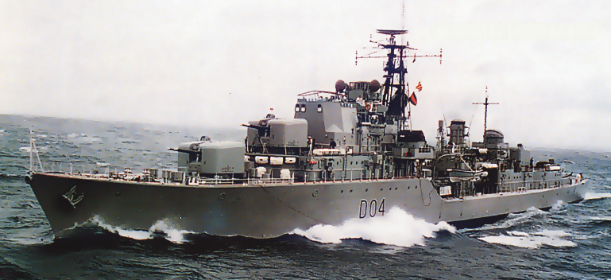
Their first sight was the massive hole ripped in Melbourne ’s bow, the half of Voyager still floating but sinking fast and life rafts full with shocked, injured, and deceased sailors.
This was the assault on the senses that 24-year-old Lieutenant Kerry Stephens faced when his command HMAS Air Nymph , a SAR vessel from HMAS Creswell arrived at the scene two hours after the collision. Nine minutes after the collision Kerry had answered the hotline call, hit the emergency siren and within two minutes Air Nymph was manned and heading out at 28 knots.
Defence Force personnel are highly trained to immediately shift into adrenaline overdrive in emergency situations, just to operate at maximum efficiency. It is widely acknowledged now the effects of trauma often comes later, sometimes decades later, with triggered memories accompanied by intense emotional and physical reactions.
It took Kerry 44 years to tell his story, and only after being pressured by his naval colleagues.
‘Many of the sailors swimming in the water were not wearing life jackets,’ he says. ‘Some could obviously see us as we approached, and calls were heard from groups of those in the water crying “ Over here, over here ”.
‘The survivors we pulled out were suffering shock, severe injuries and required medical treatment by our Surgeon Lieutenant on board. Most were covered in oil from their immersion in water and traumatised from the collision.
Kerry was about to go alongside the stern of the Voyager to carry out a search for anyone still onboard. However, a Chief Ordnance Artificer from the destroyer, who had been recovered from the water, said he was the last to leave the stern section and assured him that there was no-one left onboard.
‘I always worried that I should have gone alongside the stern to check for survivors, and it wasn’t until 2008 at a lunch with a Voyager survivor that my mind was laid to rest. It’s a long time to wonder if you left some to die.
‘Our crew also brooded on our actions that night. In the following days, many of them came to see me and asked if there was anything more that they could have done, and whether we missed people in the water.’
It was disappointing for Kerry that no acknowledgement, praise or thanks was ever received for what the SAR crews did that night during the rescue operations.
‘They saw many horrific things but did what they had to do, without question or hesitation,’ says Kerry. ‘They all showed initiative under extremely traumatic conditions and performed their duties above and beyond what would have been expected of sailors of their age and experience.’
It was the same for the sailors on Melbourne , whose quick actions plucked 180 souls from the water in their lifeboats. The operating theatre and sickbay were ready to receive the injured.
However, for a long time a completely unfair and untrue rumour of fault followed the Captain and crew of Melbourne. The subsequent inquiry clearly exonerated Captain Robertson and his crew. But that did not diminish the ‘survivor guilt’ and perceived stigma of being on Melbourne . Until recently few memorial services even mentioned them.
One such sailor was Bob Clarey, a very young Stoker on Melbourne who was catching some night air on a break with a mate, sitting on the superstructure behind the funnel. This gave him a bird’s eye view of the whole accident. After ‘action stations’ was called, Bob scrambled to the deck and spent the next few hours getting the survivors ready for medical attention.
‘I remember the collision, it replays in my mind in nightmares, but I have no recollection of the two weeks I spent in the Balmoral Naval Hospital afterwards, where I was being psychologically assessed for what they called battle fatigue.’
Bob was just 16 years of age, a junior recruit. He never had his career in the Navy, leaving after 18 months due to post-traumatic stress disorder (PTSD).
‘We had no counselling, thanks or recognition of our role that night. For years we were thought of as the bad guys of the Navy who had caused the accident.’
Only recently the crew of Melbourne were included in Voyager ceremonies which Bob has attended at St Marys at Kangaroo Point at the memorial to the tragedy. ‘I feel compelled to go, but it brings it all back to me – it’s a meltdown.’
Two Naval Association members, John King and Noel Chidley were called out on the minesweeper HMAS Ibis from Jervis Bay.
‘We went out and back three times that night, only finishing at 1030 the next morning,’ says Noel. ‘On one trip we could only travel at four knots as we were escorting the admiral’s barge which had men so badly injured that they couldn’t be moved, some not expected to make it. One sailor was missing an arm. Every time there is a shipping accident in the news, I have flashbacks, all bathed in that eerie green from the spotlights we set up on deck to look for men in the water.’
‘It is my hope that if those who are still alive read this article, they can be assured that the exceptional way they all performed their duties will never be forgotten,’ says Kerry.
A short ceremony is held at 10.30am on the last Thursday of every month at the Jack Tar statue in the South Brisbane Memorial Park. At each ceremony, a guest from the relevant part of the RAN tells their story in front of veterans, serving RAN personnel, descendants, and the general public.
This month, we will commemorate the Melbourne/Voyager disaster on Thursday 24 February. All welcome.
For more information: Jayne Keogh 0418 882 408 / naaqldmedia [at] outlook.com (naaqldmedia[at]outlook[dot]com) .
For anyone impacted by this article, support is available at Open Arms – Veterans & Families Counselling service. Open Arms has a range of specialised trauma-informed, military aware services, including counselling and group programs. Call 1800 011 146 for free and confidential support or visit www.openarms.gov.au

- Virtual War Memorial Australia

- Lockleys Servicemen's Memorial Centre Inc
- Community Pages
- Schools Program
- Resources for Teachers
- Resources for Students
- Professional Learning 2024
- Premier's ANZAC Spirit School Prize
- DVA Anzac Day Schools Awards
- Research Project / AIF
- Ohlstrom Short Film & Resources
- VWMA Excellence Award
- Excursion: Adelaide Commemorative Precinct Walking Tour
- Podcast: Bringing His Spirit Home: Private Arthur Thomas Walker, Ngarrindjeri ANZAC
- Podcast: Walking in Two Worlds: The WW1 Story of Ngarrindjeri ANZACs Cyril & Rufus Rigney
- Podcast - The Sudden Storm: The Bangka Island Massacre
- Podcast: ‘When the War Comes Home: Beachport Mine Tragedy’
- From A Whisper To A Bang! Podcast
- Victory in the Pacific
- ANZAC Day Resources
- Remembrance Day Collection
- VWMA Video - Causes of World War One
- Australian Women in War
- Flickr Image Collection
- Home Page Stories
- November 1918 - by Robert S Kearney
- War Diaries
- Indigenous Service People
- Their Service, In Their Words - A Collection of Tribute Profiles with Curated Interviews
- The Victims of the Bangka Island Massacre
- Podcast: Walking in Two Worlds: The WW1 Story of Ngarrindjeri ANZACs Cryril & Rufus Rigney
- The Royal Australian Air Force Through the Ages: A Collection
- Twins in service of the Nation
- How-To Guides to Research
- Adding Site to Mobile Device
- How to create a QR Code on PC
- Listing Rules
- Make a Donation
- VWMA Honours and Awards
- Volunteering
- Gifting Policy
- Terms & Conditions
The HMAS Melbourne-HMAS Voyager Collision: Australia’s Worst Peace-Time Naval Disaster
Nicholas egan.
__HMAS_Voyager_(D04)_and_HMAS_Vendetta_(D08)_underway__circa_in_1959_(AWM_301014).jpg)
On the 10th of February 1964 a terrible naval accident took place in Australian waters that led to 82 deaths. Off the coast of the Royal Australian Navy base at Jervis Bay, the aircraft carrier, the HMAS Melbourne and the destroyer, the HMAS Voyager were conducting maneuvers when it soon became clear that the 2 ships were heading for collision. Both crews desperately tried to change course, but it was too late.

HMAS Melbourne struck Voyager at 20:56, with the carrier's bow striking just behind the bridge and cutting the destroyer in two. Of the 314 aboard Voyager, 82 were killed, most of whom died immediately or were trapped in the heavy bow section, which sank after 10 minutes. The rest of the ship sank after midnight. Melbourne, although damaged, suffered no fatalities, and was able to sail to Sydney the next morning with most of the Voyager survivors aboard. The loss of the Voyager ranks as the 6th most deadly loss of life in Australian navy history.[i]

The incident shocked the public and memorial services were held around Australia on 21 February. Public distrust in navy led inquiries over the previous few decades resulted in a Royal Commission being called to investigate the cause of the disaster. The commission, led by former Attorney General Sir John Spicer, concluded that the collision was primarily the fault of Voyager's bridge crew, in that they neglected to maintain an effective lookout and lost awareness of the carrier's location, although he did not blame individual officers. When reporting on the contribution of Melbourne and those aboard her to the collision, Spicer specifically indicated failures of its captain John Robertson and two other bridge officers, as they did not alert Voyager to the danger she was in, and appeared to not take measures to prevent Melbourne from colliding. Robertson submitted his resignation from the Navy and was considered to be a scapegoat by the media.[ii]
Over the next few years there was increasing pressure from the public, the media, and politicians of the government and opposition over the handling of the first Royal Commission, as well as claims made by Lieutenant Commander Peter Cabban, a former officer of the Voyager, that Captain Duncan Stevens frequently drank to excess and was unfit for command. Eventually in 1967, Prime Minister Harold Holt announced that a second Royal Commission would be held.
The second Royal Commission found that Stevens was medically unfit for command, although not impaired by alcohol at the time of the collision, he was suffering from a duodenal ulcer and had been confidentially prescribed amphetamines. Consequently, some of the findings of the first commission, those based on the assumption that Voyager was under appropriate command, were re-evaluated. Robertson and the other officers of Melbourne were absolved of blame for the incident.

In the aftermath of the disaster, Chief Petty Officer Jonathan 'Buck' Rogers was posthumously awarded the George Cross for his actions during the sinking. Recognizing that he was too large to fit through the escape hatch, he organised the evacuation of those who could escape, then led those stuck in the compartment in prayers and hymns as they died. Posthumous Albert Medals for Lifesaving were awarded to Midshipman Kerry Marien and Electrical Mechanic William Condon for their actions in saving other Voyager personnel at the cost of their own lives.[iii]
5 Years later, the HMAS Melbourne was tragically involved in a second naval disaster, this time with the American Destroyer USS Frank E. Evans in the South China Sea. Evans sailed under Melbourne's bow, where she was cut in two. 74 of Evans's crew were killed.

A joint RAN–USN board of inquiry was held to establish the events of the collision and the responsibility of those involved. This inquiry, which was believed by the Australians to be biased against them, found that both ships were at fault for the collision. Four officers (the captains of Melbourne and Evans, and the two junior officers in control of Evans at the time of the collision) were court-martialed based on the results of the inquiry; while the three USN officers were found guilty, the RAN officer was cleared of wrongdoing.[iv]
There are a number of memorials to those who were killed in both tragedies. In Jervis Bay stands a memorial to the HMAS Voyager and in Gurnee, Illinois stands a memorial to those who were lost in the USS Frank E. Evans disaster.

USS Frank E. Evans memorial located in Warren Cemetery, Gurnee, Illinois. Wikimedia Commons Author: GoodSam111 https://en.m.wikipedia.org/wiki/File:USFEE_memorial_large_tablet.jpg
References [i] Frame, Tom (2005). The Cruel Legacy: the HMAS Voyager tragedy. Crows Nest, NSW: Allen & Unwin. ISBN 1-74115-254-2. OCLC 61213421. [ii] Spicer, Sir John Armstrong (1964). Report of Royal Commissioner on loss of H.M.A.S. "Voyager" (Report). https://trove.nla.gov.au/version/46252538 Melbourne: A.J. Arthur, Commonwealth Govt. Printer. [iii] Burbury; Asprey & Lucas (1 March 1968). "Royal Commissioners' Report on Voyager Inquiry" (PDF). http://www.navy.gov.au/sites/default/files/documen... Navy News. Vol. 11, no. 5. Parramatta: Cumberland Newspapers Pty Ltd. [iv] Stevenson, Jo (1999). In The Wake: The true story of the Melbourne-Evans Collision, Conspiracy and Cover-up. Alexandria, NSW: Hale & Iremonger. ISBN 0-86806-681-8. (Author Jo Stevenson was the wife of Captain John Phillip Stevenson, the Commanding Officer of Melbourne at the time of the collision)
- Content Reports

Search form
- Ship Histories
- Aviation Histories
- Base Histories
- Biographies
- Customs & Traditions
- Publications
You are here
Hmas voyager (ii).
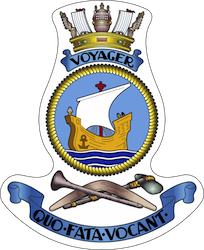
Advances in destroyer design in the United Kingdom during the mid to late 1940s resulted in the design of the Daring Class, originally described as light cruisers. The Australian built Daring Class Destroyers were similar to the eight similar vessels being built for the Royal Navy, but with modifications for Australian conditions, with good ventilation and air conditioning being a priority.
Four Darings were initially ordered for the RAN, although only three, Voyager (II), Vendetta (II) and Vampire (II) were eventually completed. Voyager (II) was ordered on 3 December 1946 from Cockatoo Island Dockyard, and became Ship Number 188 on their records.
The Darings were built in sections, upside down from the centre, then rolled onto the slipway. They were the first prefabricated all welded ships to be built in Australia, and used light alloys extensively both in the superstructure and in interior sub-divisions and fittings. At the time they were the largest conventional destroyers to be built for the RAN.
Construction of the ships was delayed due to industrial disputes, skilled manpower shortages, and delays in the supply of materials and vital machinery drawings from England. Between ordering and completion, the cost of each Daring increased from £2.6 million to almost £7 million! Voyager (II)’s final cost was over £6,750,000.
The Daring Class brought a new standard of accommodation to the RAN with air conditioning, cafeteria messing and bunks instead of hammocks.
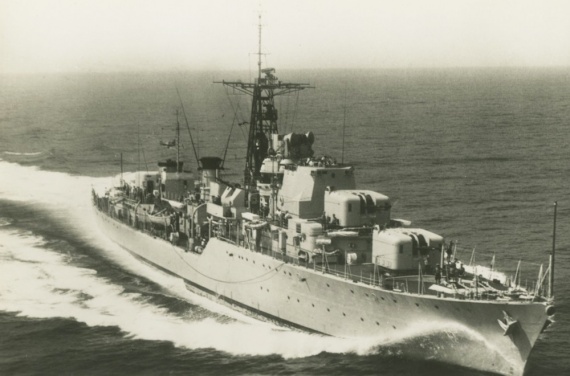
The Darings were designed and built as versatile, multi-purpose ‘Gun Ships’ with three separate weapon control systems to control the main and secondary armament. In the Naval Gunfire Support mode for example, the main Gunnery Fire Control System was capable of providing very accurate and rapid fire to a range of nine nautical miles (18,000 yards) in normal mode and in excess of ten nautical miles (20,000 yards) in extended range mode. At a rate of fire of 16 rounds per gun per minute, the Darings were capable of firing up to 100 x 4.5-inch shells per minute, with each standard high explosive shell weighing 56-lbs.
Voyager (II), the first ship to complete, mounted three twin 40mm Bofors, one either side of the bridge superstructure, and the third abaft the second funnel. Both Vampire (II) and Vendetta (II) were completed with two single mounts abreast the superstructure and two twin mounts (one on each beam) abaft the second funnel.
The following is an extract from HMAS Voyager (II)’s ‘Welcome Aboard’ brochure, which elaborates on the innovative features of the then new class of warship:
Voyager (II) is the first of three Daring Class ships to be placed on order with Australian Shipyards by the Australian Commonwealth Shipping Board. This class of ship is a departure from the conventional destroyer both in general design, armament, and number of personnel carried. She has the striking power of a light Cruiser (the disposition of her main armament being typical of that type of ship), coupled with the latest anti-submarine weapon and detection devices. Furthermore, her manoeuvrability is superior to that of even the most modern conventional destroyer, owing to the fitting of twin rudders. The other two ships of the class, in varying stages of construction, are Vendetta (II) and Vampire (II)...The ship carries two 25-foot motor-cutters powered by diesel engines, a 27-foot sailing whaler for use as a sea boat, and a 14-foot sailing dinghy for recreational purposes. War experience has shown that boats were vulnerable to damage by bomb and shell splinters, with the result that they were usually unserviceable if required for life-saving purposes. Voyager (II), therefore, carries the latest type of inflatable life raft. When not in use, these rafts take up very little space on deck, but when inflated, they will comfortably hold 20 men each, and in addition afford complete protection against the sea and elements. Sufficient of these rafts is carried to accommodate the entire ship's company. In addition, a Land Rover is carried for transport for the Postman and for general official duties. It is stored on the upper deck at sea... Voyager (II) is propelled by two out-turning propellers, each propeller-shaft being driven by its own high pressure, high-temperature turbine unit through double reduction gear. Steam for these turbines in provided by two Foster-Wheeler controlled superheat waterwall boilers...Fresh water for boilers and for domestic use is produced by two Caird and Rayner evaporator units, which are capable of a rate of 100 tons a day. Main machinery and boilers are arranged in what is known as ‘The Unit System’ ie, each shaft is driven by its own engine room and boiler room, though these can be inter-connected if required. Action damage to the main machinery is therefore more localised than in the conventional destroyer arrangement of only one engine room.
Content links
Collision with hmas melbourne (ii), 1964, queen honours voyager men.
- List of casualties
- Commanding Officers
Bibliography
Accommodation and habitability.
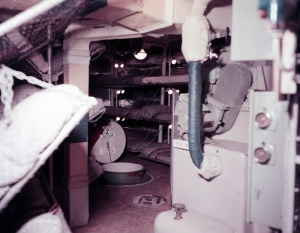
Voyager (II)’s complement comprised 17 officers and 297 ratings. Officers were accommodated in single, two and three berth cabins dispersed throughout the ship. Ratings slept in three tiered bunks, each fitted with its own reading lamp. The bunks were folded vertically when not in used to allow for expanded recreation space.
The cafeteria was separate from sleeping spaces and junior ratings collected their crockery from the galley where meals were served by cooks before sitting down to dine. The senior sailors mess was separate from the main cafeteria and their food was served by a duty messmen. There were usually three sittings for each meal to reduce the dining congestion and allow for watchkeeping. The ship has three galleys - the wardroom galley, serving the wardroom situated above, by means of a food hoist, and two ship’s company galleys, the forward galley feeding 220 junior ratings and the after galley serving up to 80 senior sailors. The after galley also incorporated a bakery that met the daily bread requirements of the entire ship’s company.
Each rating had his individual locker in which to stow his kit. Domestic facilities included a laundry which catered for the majority of the week’s wash. Built-in ironing boards were provided in each mess.
The ship carried a 16mm cine film projector and screenings were held when the ship’s programme permitted.
Fighting efficiency
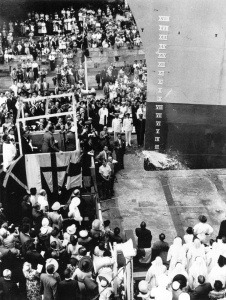
A further extract from the ship’s ‘Welcome Aboard’ brochure reflects on the fighting efficiency of Voyager :
With the present day complexity of gunnery, torpedo and anti-submarine equipment, it has become necessary for the captain of the modern warship to control his armament from the same compartment as that in which the tactical situation is being presented. (This latter is obtained by means of radar, other ships’ reports, intelligence, etc., and the information so derived is plotted and a comprehensive picture of all forces, both friendly and enemy, within many miles of the ship is obtained). Furthermore, with the advent of the Atomic Era, this compartment must be proof against radiation resulting from a nuclear attack. So it is that in Voyager (II), it is possible to locate the enemy, manoeuvre the ship into the most advantageous position and control the armament all from the one air-conditioned, gas-tight compartment. The degree of control is also such that, if needs be, the ship could be navigated with safety into almost any harbour in the world from this compartment without the use of visual aids. An integral part of the ship’s efficiency as a fighting unit is her communications. Voyager (II) is equipped with the latest radio electronic equipment capable of transmitting and receiving messages to and from anywhere in the world. In addition she is able to talk to both ships and aircraft by ‘radio-telephone’ on all frequencies in common use. All this equipment can be controlled from gas-tight compartments and can be run off batteries if electrical power fails. Signals can also be passed to and from ships in visual range by means of flags and signalling lamps. (The largest of these lamps is 20 inches in diameter and can if necessary be used as a searchlight).
Voyager (II), the first of the Royal Australian Navy’s new Daring Class destroyers, was launched on 1 March 1952 by Mrs Patti Menzies (later Dame), wife of RG Menzies (Prime Minister 1939-41, 1949-66). The official party at the ceremony included the Prime Minister, Mr Robert Menzies, Mr William McMahon, the Minister for the Navy, and Vice Admiral Sir John Collins , Chief of Naval Staff.
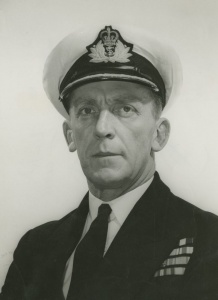
With Acting Captain GJB Crabb, DSC, RAN as her first Commanding Officer, HMAS Voyager (II) was commissioned into service in a traditional ceremony on 12 February 1957. As the first of the Daring Class of destroyer entering Royal Australian Navy service, she had an extensive trials and workup period, spending the first eleven months of her career in Australian waters. Captain ‘Buster' Crabb was fiercely and passionately enthusiastic about the capabilities of Voyager (II) and the new Daring Class.
Voyager (II) underwent a refit from 28 September 1957 to early January 1958. This was followed by a demanding workup in the Jervis Bay exercise areas. On 13 January 1958, she departed from Sydney with her Tribal Class destroyer consort, HMAS Warramunga (I), in company, proceeding via Cairns and Darwin; bound for an eight-month deployment with the Far East Strategic Reserve.
The role of the Strategic Reserve was to deter communist aggression in South East Asia by defending Malaya and Singapore, and their sea lines of communication. It also assisted in the maintenance of Malaya’s internal security by participation in operations against the Malayan Races Liberation Army, the armed component of the Malayan Communist Party.
Gavin Ryan was an Ordinary Seaman Signalman on that first deployment. The April-June 1997 edition of ‘The Navy’ included a feature by Ryan. He recalled that:
...from Cairns the cruise was quite wonderful. We were in the tropics and the Great Barrier Reef, truly the stuff of dreams. Flying fish became a common sight as they flew across the water, skipping off our bow and stern wakes. Water snakes and turtles were also seen in some numbers, along with the occasional manta ray and shark. The colour of the sea changed from a dark inky blue into more turquoise, and then even green as we proceeded further north.
Ryan also documented the ship’s Crossing the Line ceremony:
It was inconceivable that a brand-new ship like Voyager (II), with so many new chums in the crew, was going to cross the Equator quietly...When the day of the crossing arrived, a canvas pool was rigged in the waist, and Neptune’s court assembled close by. Those of us who had never crossed the line before were ‘duly initiated’ by being thrown somewhat unceremoniously into the pool, after being presented to King Neptune and his terrifying, motley gang of assistants. Actually we Ordinary Sailors got off pretty lightly. The real fun was when certain senior officers and the Chief Coxswain received their sentences and subsequent punishment...The way everyone joined in on the fun and accepted the fiendish indignities some had to bear, was testament to the high morale and comradeship that had developed in the ship since we had left Sydney almost two weeks before.
On 27 January 1958, Voyager (II) and Warramunga (I) steamed up Johore Strait and berthed at Her Majesty’s Dockyard Singapore, to be officially welcomed by a Royal Marine band and senior Royal Navy (RN) officers.
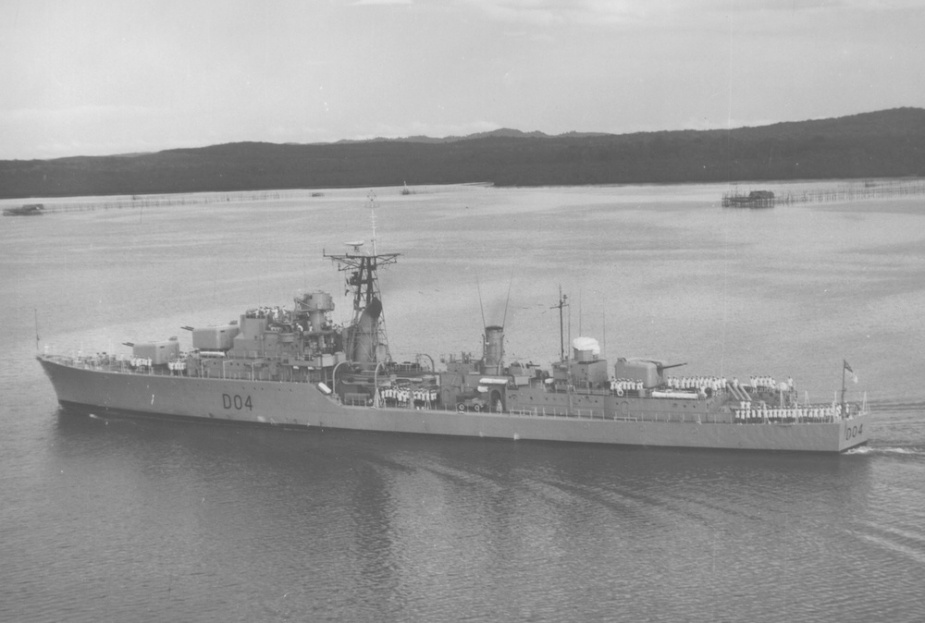
Located on the northern end of Singapore Island, about 10 miles from the city, the Dockyard was part of HMS Terror , the Royal Navy Base, and home for the Royal Navy. The base provided the offices, accommodation and facilities to sustain the Navy presence, while the dockyard provided the skills and facilities to repair and maintain the ships.
Although not as well appointed as its US Navy counterparts, HMS Terror ’s facilities included a large two-storey colonial building housing ‘The Armada Club’, the Junior Sailors’ Wet Canteen; large sporting fields, swimming pools, cinema, and, of course, Aggie Weston’s. The local village of Sembawang also catered for the vast number of sailors stationed in and visiting Singapore. Sembawang had numerous bars, each of which had its own collection of ships’ crests, plaques, photos and trinkets donated over the decades from hundreds of ships from countless navies.
Singapore, home of Anchor and Tiger Beers, the Tiger Balm Gardens and Change Alley - as a Navy News article of the time said:
And so to Singapore; city of smells, exotic food, rain, taxis, bicycles, Noritake and Tiger Balm Gardens. In spite of the advice given by the Provost Marshal, Singapore, the local taxi drivers had a harvest on the road from Singapore to the Dockyard. Still, one can hardly ride in a bus carrying a 95-piece Noritake dinner set under one arm, while holding a tape-recorder and tricycle under the other.
Voyager (II)’s first birthday was celebrated on 12 February 1958 in the Singapore exercise areas, as she worked up to full efficiency for forthcoming exercises. She was then actively involved in Exercise FOTEX with Royal Navy fleet units, 21 February-1 March. This was followed by a short goodwill visit to Penang, 2-4 March. Penang is about 280 miles up the West Coast of Malaysia from Singapore and is the oldest British Settlement in the Far East. It comprises Princes of Wales Island and the strip of mainland opposite known as the Province of Wellesley, on which is situated the RAAF Station, Butterworth.
The remainder of March was spent in Singapore, and in the local Singapore exercise areas, followed by a transit north for a three-week visit to Hong Kong for self-maintenance, where electrical items rarely seen in Australia at the time, such as transistor radios could be purchased duty free. From a Navy News item of the period:
Hong Kong, Kowloon, Wanchai - magic words - conjuring up magic pictures. Remember the Matilda Bar? The White Horse Inn? The Lah Kwok? An endless list - each different and yet the same - dedicated to two things - giving you a good time and getting your cash. The rickshaw boys really like us - they never have it so easy when we arrive. Up to six abreast, they line up, the ‘boy’ in the chair and the matelots prancing in the shafts waiting for the start. For the gourmet, Hong Kong is a very fertile field. ‘Jimmy's Kitchen’ stands at the top - his menu is an indexed book and one spends an anticipatory ten minutes or so, drooling over it before one orders...Then the floating restaurants at Aberdeen - select your fish, crays and prawns from the flood-lit tanks and then watch from your table as they are cooked. Ah! Pass the bi-carb!
Other ports visited during the deployment included Manila, Yokohama (gateway to Tokyo), Otaru and Sasebo. Voyager (II) and Warramunga (I) passaged to Japan via the Formosa Strait. Given the state of political tension between China and Taiwan, the ships proceeded through the area flying large White Ensigns, and closed up at Action Stations.
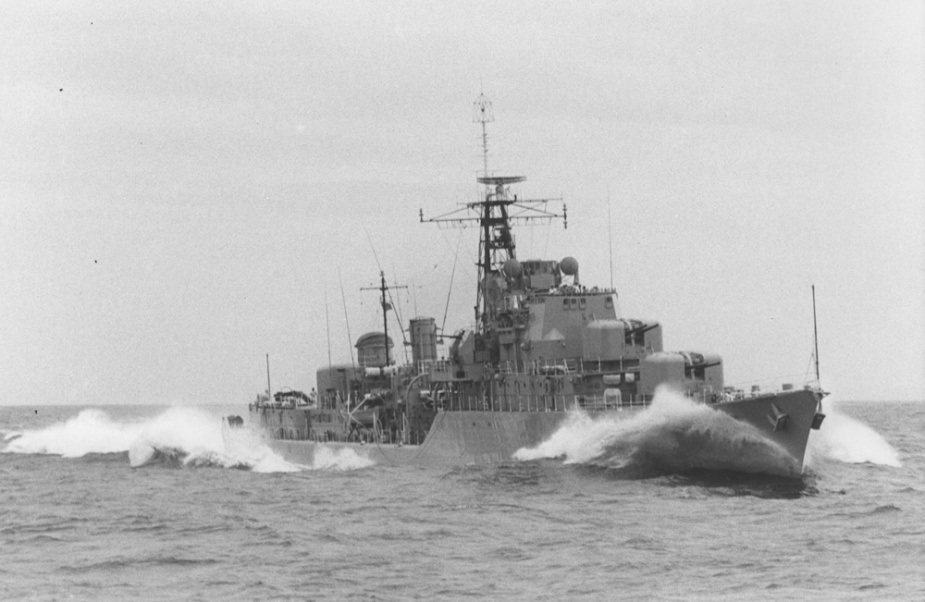
Voyager (II)’s crew really enjoyed the ship’s visit to Japan, as the Australian currency at the time was very strong, with one Australian pound buying 800 Japanese yen. The ships returned to Sydney via Western Australia, arriving back in their home port on 3 September 1958, for refit and leave, after an eight month deployment.
While ‘up top’, Voyager (II)’s and Warramunga (I)’s ship’s companies had raised money to buy a large quantity of toys in Singapore and Hong Kong, for Australian crippled children, and these were distributed in various ports on their return.
The Navy News of 9 January 1959 contained the November 1958 Navy Advancement List which included promotions for the following Voyager (II) sailors:
Following her return to Australia, Voyager (II) underwent a refit that kept her in dockyard hands until late January 1959. The first event of note for 1959 was a Change of Command ceremony on 7 January, with Captain WJ Dovers assuming Command from Captain GJB Crabb.
On 20 February 1959, Voyager (II) was one of six RAN and Royal Navy ships taking part in Operation SHOP WINDOW off Sydney. From Navy News, the ships were Melbourne (II), Voyager (II), Warramunga (I) and Quickmatch (I), plus HM submarines Telemachus and Andrew . A large group of Senators and Federal Parliamentary members were aboard the carrier, including the Minister for the Navy, Senator Gorton; as was a large contingent from the press, radio, TV, movie and news photographers. The object of the exercise was to show Parliamentarians and the media just how the Navy works and fights.
SHOP WINDOW was followed the next day by Voyager (II)’s ‘Family Day’, when more than 500 relatives and friends of the ship’s company sailed aboard the ship.
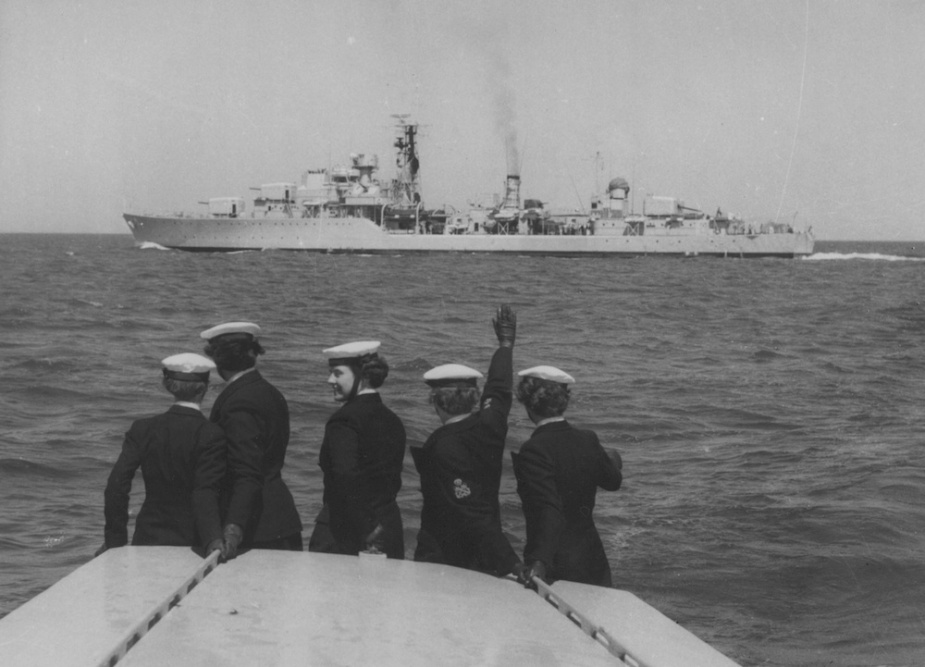
Voyager (II) departed from the Cruiser Wharf at Sydney’s Garden Island Dockyard, on 3 March 1959 for further Far East service, sailing ‘Westabout’ via Bass Strait and the Great Australian Bight, in company with other fleet units. Her Annual Full Power Trial was successfully completed on 5 March 1959. The 3 April 1959 edition of Navy News reported:
Our visit to Adelaide is something the ship’s company will always remember. We sailed up river and berthed within easy striking distance of the city. The Officer of the Guard brought onboard information with details of the hospitality which had been arranged for Voyager (II) during our stay. These included dances, RSL club facilities, sporting fixtures for the ship...On Sunday the ship was open to the public and 4000 visitors, including a large percentage of very energetic small boys, came to look over the ship. On leaving harbour we led on down the river with HMS Cossack in company to rendezvous with the fleet. Later we joined with Albion , Melbourne (II), Royalist , Chichester , Cheviot , Reliant , Resurgent and Olna . During transit to Fremantle we took fuel from the tanker, exercised replenishment from both supply ships and worked hard with both carriers flying aircraft. The Bight was quite tame and we had a pleasant passage. On the morning of Saturday March 14, when the Fleet entered Fremantle, we were given a real Western Australian welcome. Trips into the country had been arranged, parties had been organised and sporting fixtures planned. The weather has been wonderful and much time has been spent on the beaches of North Cottesloe and Scarborough. Fremantle and Perth have been tops and the credit for our welcome and hospitality goes to the WA and his staff who have performed a terrific job of organisation and coordination of functions. Our gratitude of course, goes to the Western Australians who responded as they did.
For those who like nostalgia, that edition of Navy News also advertised House and Land packages in the Sydney suburb of Bankstown for just £25 deposit, while the singer Johnny O'Keefe was featured in the 'This Week's Records' section.
En route to the Far East, Voyager (II) took part in SWANEX, a major South East Asian Treaty Organisation (SEATO) exercise in the Indian Ocean. SEATO was established under the auspices of the 1954 Manila Pact between Australia, New Zealand, Britain, the USA, the Philippines, Thailand, Pakistan, and France. It was intended to be a vehicle for collective defence, in the same way as the North Atlantic Treaty Organisation, or NATO. The regular involvement of Australian warships in these large multinational exercises provided the RAN with a high operational tempo and valuable experience it would have otherwise lacked.
The SEATO exercise was directed by the Flag Officer Commanding Australian Fleet (FOCAF), Rear Admiral GCO Gatacre, and included the largest concentration of Allied naval forces in the Far East since World War II, with RAN, RN, Royal New Zealand Navy (RNZN), Pakistani and United States Navy (USN) ships participating. The RAN contingent consisted of Melbourne (II), Voyager (II), Tobruk (I), Anzac (I), Quiberon (I) and Queenborough (I).
While refuelling from Royal Fleet Auxiliary (RFA) Olna , one of Voyager (II)'s ratings, Able Seaman GS McCabe, was injured. Following medical advice, the ship detached from the fleet and took passage to the town of Onslow, where the sailor was transferred to a Royal Australian Air Force aircraft and flown to Perth for treatment.
The long voyage from Fremantle to Singapore was enlivened by the customary Crossing the Line ceremony with King Neptune and his Court passing sentence on the 'greenhorns' amongst the ship's company, and any others who may have transgressed.
Voyager (II)'s (and the Fleet's) first port of call 'up top' was Singapore, where they berthed at the Royal Navy Dockyard at Sembawang on the northern end of the island. Voyager (II) was welcomed by the usual band of Chinese laundry hands, Charlie Farrow the tailor, and of course the inevitable traders. Navy News had this to say:
SINGAPORE - cultural Pearl of the Orient! It greeted us with its colour, its smells, heat and daily downpour. With the regularity of a well-functioning machine, every day the rain comes down as though pouring from bottomless buckets. About an hour of this, and then the Turkish Bath is on again. When does the rain start? Just after I've stepped ashore, of course! Like an all-devouring horde, we descended on the shops and stalls seeking the real ‘bargains’...a veritable babble of tongues and accents...Australian, English, Scots, New Zealand, French and American. The Commander's Memorandum was emphatic: from sunset to sunrise neither officers nor ratings were allowed to ride in trishaws. Jack must have interpreted the ‘in’ part of the edict literally, as he pedalled along a garish Eastern street with the owner gracefully reclining at ease in the passenger's chair. Highlight of the East - the CHEONGSAM!!! These graceful and provocative dresses of the dainty oriental women have turned more heads than any other single factor in the East. Every so often have I watched a group in some restaurant, bar, shop or street, nattering away nineteen to the dozen. A combination of high heels, slender shape and Cheongsam trips by, and the brilliant conversation dies away, replaced by rapt stares and open mouths. SINGAPORE has many colourful, crowded cemeteries and similarly crowded hospitals, the main source of supply for both coming from local taxis. Three things only are essential in this Singapore taxi service - a racing engine, an ear splitting horn and a wooden faced maniac at the wheel. If one survives a single journey from the dockyard to the city, a firm foundation for plate sized stomach ulcers has been laid. Mother Nature, in her anxiety to preserve the species, induces a semi-comatose state for subsequent journeys, and the unfortunate fares hurtle along, cowering in the corners of the back seat, alternately breathing prayers and threats, the while gazing with unseeing eyes as villages, cars, buses, trucks, bikes, trishaws and pedestrians flash by. Truly here on these roads one learns the real meaning of the ‘quick and the dead’.
Voyager (II) departed Singapore on 2 April 1959, in company with the cruiser, HMS Ceylon . Also in company were HM Ships Newfoundland , Cheviot , Cossack , Cardigan Bay , St Brides Bay , Alert , and HMA Ships Quiberon (I) and Queenborough (I). The ships took part in Exercise FOTEX, a weapon training period designed to provide an opportunity for Commonwealth ships on the Far East Station to work up their weapon efficiency prior to Exercise SEA DEMON. One of the highlights of FOTEX was Voyager (II)'s participation in the cruiser Newfoundland 's sea inspection. From Voyager (II)'s Report of Proceedings (ROP) dated 11 May 1959:
Voyager (II) was detached at noon (Thursday 2 April 1959) to act as consort for the sea inspection of HMS Newfoundland by the Flag Officer Second-in-Command Far East Station. The setting for the inspection was a novel one. Voyager (II) represented a British Merchantman which had been captured by pirates and which was steaming slowly towards Chinese Territorial Waters with about one mile to go. Our job was to draw as many people out of Newfoundland in addition to the Boarding Party before she was subjected to air attack and the internal inspection began. By various subterfuges, Medical, Fire and Repair, additional Boarding and other parties were gradually enticed out of Newfoundland who then suffered under air and submarine attack and other incidents to test fighting efficiency. This inspection was in my view very soundly conceived and provided a thorough test of Newfoundland' s ability to deal with the unexpected. This she apparently did despite trying circumstances. We in Voyager (II) thoroughly enjoyed our afternoon.
Voyager (II) spent Day 1959 in the South China Sea, participating in Exercise SEA DEMON, a challenging SEATO exercise, involving 27 surface ships, three submarines, naval and landbased aircraft from member nations. SEA DEMON was sponsored by Australia and directed by FOCAF aboard HMAS Melbourne (II). A ceremonial entry into Manila was the final exercise evolution.
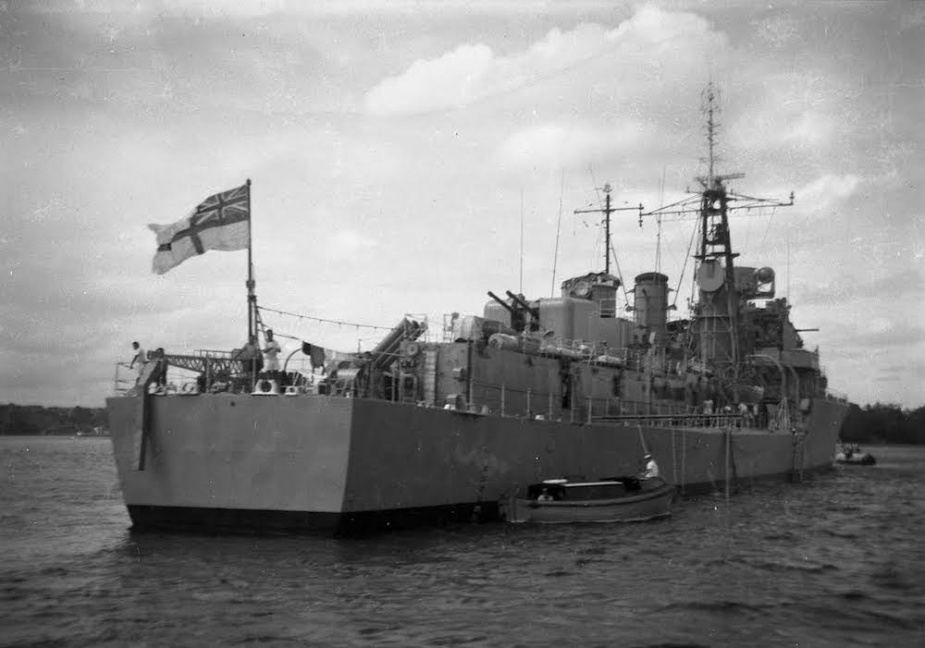
On Thursday 30 April, Voyager (II) sailed from Manila on passage to Hong Kong in company with other RN and RAN units. On that date, the ship suffered a serious mechanical breakdown when two waterwall tubes in the saturated furnace in ‘B’ Boiler Room burst causing damage to other tubes and to the furnace floor. After an hour's delay raising steam in ‘A’ Boiler, the ship continued her passage to Hong Kong, for repairs.
1 May 1959, saw Voyager (II), in company with Melbourne (II) (flag), Tobruk (I) and Anzac (I) arriving in Hong Kong on a goodwill visit. Voyager (II) remained in ‘Honkers’ for over six weeks repairing mechanical defects and undertaking general maintenance.
Navy News of Friday 10 July 1959 included a list of Naval personnel who had been advanced in rate effective 8 May 1959, including the following Voyager (II) sailors:
Hong Kong, the British Crown Colony on the doorstep of China, greeted the ship in its inimitable fashion, with traders springing from everywhere anxious to do business. Hong Kong, even including the New Territories on the mainland, is only about 400 square miles; about the area of half a dozen good-sized Australian sheep stations, and yet in the late 1950s the population was approximately three million. The size of Hong Kong was increasing daily, not by encroaching into Communist China, but by reclaiming land from the sea. Inlets were being filled in, and the strait separating the island from the mainland was being narrowed. Multi-storied flats and factories were built upon this new land with feverish haste. One could wonder, too, at the extension of the Kai-Tak airstrip many hundreds of yards into the sea. The skyline seemed to change almost daily, not only because of new construction, but because hilltops and small mountains, which were whittled down and returned to the sea in the process of reclamation, until they were levelled sufficiently for new buildings to be erected.
From the ship's ROP, during this long period in Hong Kong, Voyager (II) made full use was made of the Stonecutters Rifle Range for Annual Musketry courses. Landing parties and demolition teams were exercised, and the ship's divers were exercised by day and by night. Interpart knockout competitions in various sports were popular, as were weekend tours of the Island by motor launch, while ships of the Hong Kong flotilla took parties to sea with them on daily patrols. Voyager (II)’s Aussie Rules team played two hard fought matches against the flagship, but unfortunately for the 'voyagers', their opponents were the better team.
For the first two weeks in Hong Kong, the ship’s company was occupied in completing the ‘paint ship’ begun the previous month, a task made difficult by the abnormally heavy rains that curtailed upper deck activity. The final three weeks of the port visit saw the entire Engineroom Department working continuously in three watches throughout each 24 hours, chemically cleaning and retubing both boilers. In all, over 300 tubes in ‘A’ and ‘B’ boiler rooms were replaced, with oil contamination of boiler feed water being confirmed as the cause of the boiler failures.
Very little boiler feed water was available in Hong Kong; and it was not until 50 tons was provided by USS Shangri-La that steam could be raised and machinery trials carried out.
The ship's Navy News ‘scribe’ provided a different perspective on the port visit:
The ship’s company of Voyager (II) recently found themselves doing the rather pleasant punishment of confinement to Hong Kong for 45 days. The ships berthed and the traders sprang from everywhere. On all sides could be heard business transactions such as “Very good! I show you” or “More better you buy from me - you pay later!” This show of goodwill and eagerness to strike a good bargain usually to the entire satisfaction of the trader, claimed no small number of the ship's company. However, the more sturdy types who had clung to their Hong Kong dollars, got to shore. Here they found themselves in a maze of one way streets, some of them no wider than George Street, with big American cars and rather smaller rickshaws all behaving like ‘dodgem cars’. At this stage the Australian Association stepped in and took us on a bus trip around the island and new territories. This showed us the finer points of navigation in Hong Kong and also the places to go. Soon the ‘rabbits’ began to flow into the ship: cane chairs, cheongsams, camphorwood chests, umbrellas, transistor radios, coffee tables and suits by the score! The ship sank lower and lower in the water as bottom now covered with coke bottle tops came up to meet her. The initial wild period of good trade soon began to wane as our ‘Voyagers’ found their purses getting lighter and lighter. This was different! Whereas usually one would find that there was little time and plenty of money to spend, our heroes found that it was just the opposite. Aussie Rules, rugby, soccer and hockey games were played off in Hong Kong’s Happy Valley much to the mutual enjoyment of the locals and the players. Volleyball and swimming events were held at HMS Tamar. Eventually the time came for the last mess party to be held and for the last ‘rabbit’ to be brought onboard. Voyager (II) was leaving Hong Kong. The ‘voyagers’ finally left for home on June 15, some sorry to leave, but the majority looking forward to getting back home once again after a very eventful cruise which has rightly been topped off with 45 days in Hong Kong - the Pearl of the Orient.
Thus, on Monday 15 June, Voyager (II) slipped and proceeded from Hong Kong in the midst of a torrential downpour, bound for Darwin. On departure from ‘Honkers’, the ship was carrying two passengers, Mike Chieza and Frank Martin, both ex-paratroopers from London. They were hitchhiking around the world, and ‘hitched’ a ride to Sydney aboard Voyager (II) as part of their world tour.
While on passage through Indonesian waters, given the political situation, the ship’s armament was cleared away, but no ships or aircraft were sighted.
Following Voyager (II)’s arrival in Darwin on 22 June, 400 tons of fuel was embarked in just four hours and the ship departed on passage to Cairns. After an uneventful passage, she arrived in Cairns on 25 June, and after embarking fuel, mail and fresh provisions, sailed for Sydney after spending just three hours in port.
Voyager (II) secured alongside Garden Island’s Fitting Out Wharf on Monday 29 June, where the ship’s company was greeted by relatives and friends. The ship was rapidly denuded of the many ‘rabbits’ brought home as the majority of the ship’s company proceeded on leave.
The ROP for June 1959 notes an evolution totally foreign to contemporary RAN practice:
Senior rates of the new commission joined on Tuesday 30th, and the turn over was completed on Wednesday 1st July. Junior rates are due to join on Thursday 2nd, and by Friday 3rd, the ship will be running on the New Commission Ship’s Company.
The ship’s new commission Rugby Union team challenged Watson while the ship was in maintenance. Voyager (II)’s scribe had this to say about the match:
This match was completely unfair. The Watson team was bigger, better, fitter and faster than us. We consisted of 15 gentlemen from HMAS Voyager (II) who, playing together for the first time, gave a convincing demonstration of gentlemen playing together for the first time. We were discouraged by the fact that 98% of the spectators were from Watson. The score was WATSON 35, DESTROYERS 6 - as if that mattered.
On completion of her maintenance period, Voyager (II) was mainly involved in work up and exercises off the east coast of Australia during the period 29 September to 28 October 1959. A highlight during this period was Navy Week. On Friday 9 October, Voyager (II) was one of four fleet units led by Melbourne (II) involved in a Fleet Entry into Sydney Harbour. While the carrier berthed at Garden Island, Voyager (II), Quiberon (I), Warramunga (I) and Queenborough (I) continued on under the harbour bridge where they were given a ‘ticker tape’ welcome from the crowds on the bridge. On Saturday during Open Day at Garden Island, Voyager (II) was open to the public, where she and the other fleet units had unshrinking queues waiting to move through the ships in conducted parties.
On 20 October, the RAN’s three Daring Class destroyers, Voyager (II), Vendetta (II) and Vampire (II) operated together for the first time, conducted a series of exercises and manoeuvres in the Jervis Bay area, the trio now forming the 9th Destroyer Squadron.
The RAN’s Family Day at sea for 1959 took place on Saturday 24 October. At 09:30 in hazy weather, seven fleet units including Voyager (II), took station behind Melbourne (II), and moved down harbour and out to sea. Navy News reported that:
The programme commenced at 10:15 with Melbourne (II) launching two Venoms and two Gannets after Voyager (II) and Vendetta (II) on port and starboard side, respectively, of the flagship transferred mail by heaving line and a rating by highline. From there onwards events followed without pause...The ships entered harbour in reverse order at about 1500. Melbourne (II) was overtaken outside the Heads by the small ships doing 24 knots and each saluting in turn as they passed the Flagship.

Voyager (II) was one of four naval units which visited Melbourne for varying periods, late October to early November 1959, for the Melbourne Cup festivities, which the punters amongst the ship’s company enjoyed. A transit of the Tasman Sea followed, with the three Darings of the 9th Destroyer Squadron accompanying HMAS Melbourne (II), during a visit to New Zealand for exercises with the RNZN. During the visit Voyager (II)’s itinerary included visits to Milford Sound, Port Lyttleton and Auckland.
Showing the flag at Port Lyttleton, no less than 76 Voyager (II) sportsmen visited the Royal New Zealand Air Force base at Wigram, including two cricket teams, a 12 man tennis team, basketball team, a soft-ball squad, plus twenty-odd spectators and critics. While in port, apprentices from the merchant ship, SS City of Lucknow challenged the ship to a whaler race. As Navy News reported:
The Quarterdeck Division (with a little help from the other seamen) scratched up a crew. They were game, they were strong - but not very scientific. The race, over 5½ cables, proved that the apprentices were fit and very well trained and that our team have plenty of guts. The apprentices won by 5 lengths.
Voyager (II) returned to Sydney on 4 December 1959 and commenced a self-maintenance and long leave period.
Voyager (II)’s 1960 calendar year commenced with a Change of Command on 18 January which saw Captain Dovers handing over Command to Captain RAH Millar, RAN. The next event of note was a short visit to Port Kembla in late January.
Exercises in the Sydney/Jervis Bay area occupied most of February. This was followed, in early March, by a transit of Bass Strait and visit to Hobart, in company with Melbourne (II) and Quiberon (I). The ship's Admiral's Inspection took place while in Tasmanian waters. Participation in the Joint Maritime Exercise STARGLOBE was next; designed to test Australia's and New Zealand’s sea and air anti-submarine forces in prolonged operations; to test submarines in their anti-shipping role, and to test the Fleet air defence against land-based strike aircraft.
Navy News of Friday 22 April 1960 included a list of Naval personnel who had been advanced in rate effective 12 February 1960, including the following Voyager (II) sailors:
Voyager (II) and the carrier Melbourne (II) departed from Sydney on 28 March 1960, for three months service with the Far East Strategic Reserve, sailing via Darwin, in company with HM Ships Belfast and Cavalier for part of the passage. Voyager (II)’s Admiral's Inspection continued during the passage north, during which the ship suffered a burst boiler tube in ‘B’ Boiler, a recurrence of her previous year's boiler problems. Voyager (II) was detached to Singapore where replacement boiler tubes were embarked, and the ship then proceeded north in worsening weather, reaching Hong Kong on 15 April in an unpleasant change-of-monsoon haze.
Repairs were carried out with the assistance of Whampoa Dockyard, whose previous acquaintance with the ship helped considerably. A time limit was placed on the repairs in the interests of getting the ship to Manila in time for Exercise SEA LION. Voyager (II)’s engine room department worked long, hard hours on repairs and maintenance, during which a considerable number collapsed through heat exhaustion.
On Anzac Day a Dawn Service was held at Hong Kong’s cenotaph with over 40 members of the ship’s company attending.
From the ship’s ROP for May 1960:
Working against the clock, and with an acute shortage of feed water, ‘A’ Boiler was flashed as ‘B’ was being closed up. The ship sailed from Hong Kong for Manila at 23:30 on Tuesday 3 May with insufficient feed water to flash more than one boiler. The Engineroom team, particularly the more experienced people, had worked magnificently. That Voyager (II) took part in SEA LION (and Australia thereby met her obligation) was largely due to their efforts. It was a sad blow, following the numerous cases of heat exhaustion, that the Chief M(E) suffered a heart attack.
Exercise SEA LION involved more than 60 ships and 20,000 sailors, representing all eight SEATO member nations. Communications were no simple facet for a fleet of ships that normally use five languages, but for the two weeks of the exercise communicated only in English. For Voyager (II)’s communications department, sleep became just a word in the dictionary, as they handled communications during the exercise.
The ship’s ROP noted that Voyager (II)'s part in Exercise SEA LION was unrewarding. After all the effort of getting to Manila for the exercise, the role she played was small; the ship was moved from one group of ships to another; she was never where a submarine was known to be; and air attacks always occurred on the other side of the screen. In addition, Voyager (II)’s vintage gunnery radar set failed just before the surface and anti-aircraft firings. Using ‘guesswork’ ranges, however, the first drone target, at which Voyager (II) was the only ship firing, plummeted into the sea after only the second run!
Voyager (II) operated in and around Singapore for the remainder of May 1960, before sailing for ‘home’ on 1 June. On the following day, the ship was forced to visit the Indonesian port of Tanjung Priok to land a sailor with appendicitis. Voyager (II) then continued her passage to Fremantle via Sunda Strait, arriving in the West Australian port on 8 June. Following clearance by Customs and Quarantine, the West Australian natives went on long leave into the arms of wives, children and sweethearts.
The citizens of Fremantle invited 150 members of Voyager (II)’s ship’s company to various social events that evening. At noon on Friday 10 June, the Governor of West Australia, General Sir Charles Gairdner, held a levee, attended by Voyager (II)’s officers, in honour of the Queen’s birthday.
Voyager (II) made passage to Melbourne in seas that the newspapers described as ‘mountainous’, but which the ship's ROP saw as a quartering gale. On arrival in Melbourne on 18 June, all Victorian, South Australian and Tasmanian natives who could be spared proceeded on long leave.
The ship arrived back in her home port of Sydney on Monday 20 June for leave and refit, berthing at the Fitting Out Wharf, Garden Island Dockyard, having steamed some 11,600 miles during her deployment. From the ROP for June 1960:
Dockyard foremen and workmen boarded the ship on arrival and commenced work on the large Alteration and Addition involving the bridge superstructure. Voyager (II) was not aware this was to happen, and some delay occurred while offices and cabins were vacated. De-ammunitioning was completed at No. 4 buoy on Friday 24 June and the ship moved alongside on completion. Although the refit was not scheduled to start until Monday 4 July, a considerable amount of stripping and preparation was begun. This virtually made the ship non-operational from the time of arrival in Sydney.
The Navy News of Friday 21 October 1960 included a list of Naval personnel who had been advanced in rate effective 12 August 1960, including the following Voyager (II) sailors:
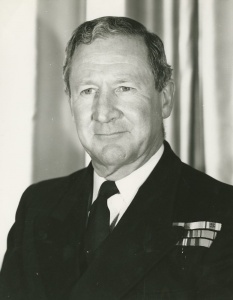
On Wednesday 9 November, a service was held aboard Voyager (II) for four ex-naval men, whose ashes were scattered on the sea. They were Lieutenant Commander TE Mullins, Lieutenant JN Walker, Mr A Buchli and Mr JR Elley.
On 14 November 1960, Voyager (II), now under the Command of Captain DC Wells, escaped the clutches of Garden Island, and officially emerged from her refit. The period to 16 December was mainly spent in the Jervis Bay Exercise Areas for a post-refit workup. From the pen of one Navy News correspondent:
With the refit behind us we come to the usual workup - a sadistic scheme, thought up in the dark precincts of officialdom, to harass the weary sailor. How disconcerting and frustrating to steam within sight of Sydney Heads, only to turn around and go the other way.
Voyager (II) had an abbreviated Christmas Leave period, 16-28 December 1960, departing on 28 December for Fremantle on passage to Singapore for a further deployment with the Commonwealth Strategic Reserve.
1 January 1961, the start of the Royal Australian Navy’s 50th Anniversary Year, saw the ship on passage westward across the Great Australian Bight. From Voyager (II)’s ROP for January 1961:
...the time on passage was used in exercising the ship's company at Defence Stations and at closing up for General Quarters. Three periods of 24 hours...were spent with the entire ship's company in three watches. During these periods numerous exercises and evolutions were carried out and hands were closed up to General Quarters without prior notice both during the days and nights.
A short port visit was paid to Fremantle, 3-5 January, for refuelling and restoring.
Passing from the southern hemisphere to the northern half of the world, Voyager (II) crossed the equator, since this could not be avoided. For those of her company who had not done this before a short and painful ceremony took place. Each 'greenhorn' was then issued with a certificate issued by King Neptune and signed by the Captain to make it legal.
Voyager (II) arrived in Singapore, the Gateway to the Mystical East, on 11 January 1961, and departed the next day, in company with the carrier, HMS Hermes , for exercises in the Singapore area on passage to Subic Bay, for combined exercises with American forces. Voyager (II)'s and Quickmatch (I)’s participation in the exercises was, however, cancelled en route and the ships returned to Singapore.
In mid-January, the Flag Officer in Charge Australian Fleet, Rear Admiral WH Harrington, made the announcement that Voyager (II) had been awarded the Commodore Wardle Cup in recognition for her prowess in communications in 1960. Her prowess in sports was also recognised with the ship becoming the Small Ships Aussie Rules Champion for 1960.
On Saturday 21 January, Voyager (II) and the frigate Quickmatch (I) sailed from Singapore on a goodwill visit to Bangkok, 24-28 January. This was preceded by a brief call at the port of Sattahip to embark a party of Thai pressmen and Thai naval officers for the passage to Bangkok. A ‘Shop Window’ display was put on for their benefit, including a ’throw off’ surface gunnery shoot by Voyager (II), torpedo firing, jackstay transfer and mortar firing.
In Bangkok, at 08:00 on Thursday 26 January, like all other RAN ships, Voyager (II) and Quickmatch (I) ‘dressed’ ship to mark Australia’s National Day. Officers from the two ships were guests of the Australian Ambassador to celebrate Australia Day, and tours were provided for the ship's companies, including visits to the Bridge over the River Kwai and the Kanburi War Memorial. Both ships were open to visitors, and they also fielded a soccer team to play the Royal Thai Navy. Other highlights of the visit were a shipboard party for blind children and cricket, tennis and water polo matches.
On 1 February, Voyager (II) rendezvoused with units of the Far East Fleet off Hong Kong, assisting in the departure screen, undertaking various exercises, and acting as plane guard for HMS Hermes during night flying. On Friday 3 February, news was received of the death of His Excellency Lord Dunrossil, Governor-General of Australia, and Colours were half-masted.
At 11:00 on Saturday 4 February Voyager (II) entered Hong Kong for 13 days self maintenance. A considerable amount of work was done on the upper deck, plus training and instruction for Ordinary Seamen and potential Higher Rates. There was also a full programme of inter-part, inter-ship and inter-service sport. In addition, four expeditions were organised, with activities including walking across Lan Tau, climbing Tam-O-Shan, diving off Lima Island, and sailing round Hong Kong in a whaler.
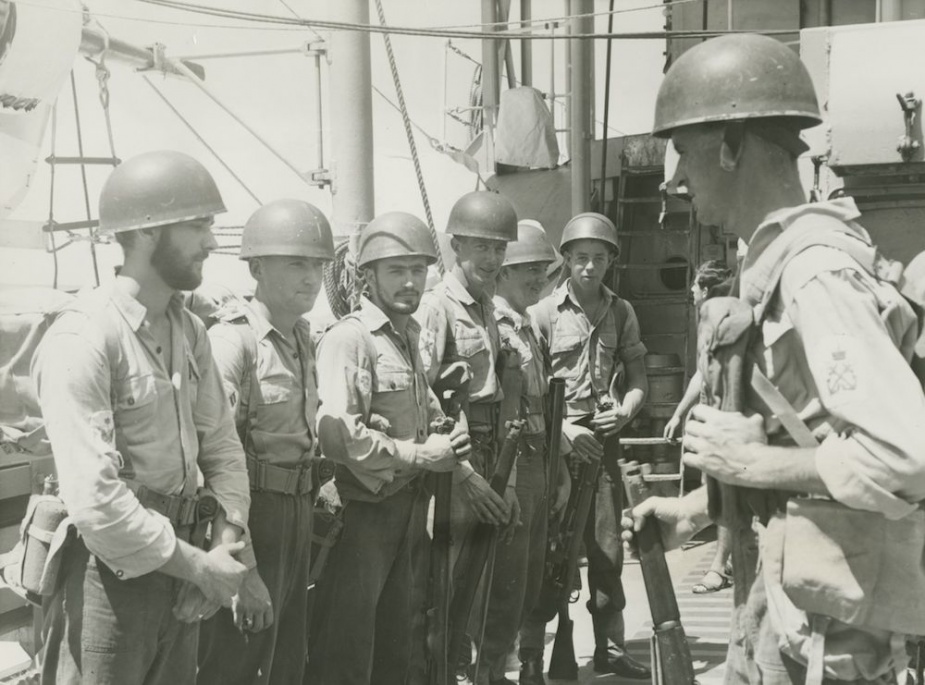
Voyager (II) departed Hong Kong for Singapore on 17 February, with the Royal Navy destroyer, Cassandra joining en route. Voyager (II)’s Annual Full Power Trial was successfully carried out on passage.
The Singapore port visit was followed by Commonwealth Maritime Exercise JET 61 in the Indian Ocean, 24 February-10 March 1961, which saw 25 warships from Australia, New Zealand, United Kingdom, India, Ceylon and Pakistan participating. The exercise ended with a Fleet Entry into Trincomalee on 10 March.
Trincomalee, the major fleet anchorage on the east coast of Ceylon (now Sri Lanka) was a very quiet ‘run ashore’ compared to Singapore and Hong Kong. It seemed that the only items offered for sale were carved elephants, ranging in size from large rampant brutes through bookends to small collections fitting into matchboxes.
Once the JET exercise fleet was anchored in Trincomalee harbour, the Fleet Whaler pulling and sailing races were held. Voyager (II) entered all races, and although she didn’t win, places were gained in the leading half of the field. ‘Hands to bathe’ was piped at Trincomalee, with the crew in all their different shapes and sizes demonstrating many and various methods of entering the water.
Trincomalee was followed in short order by a visit to Visakhapatnam, 16-19 March, a port on the east coast of India. While in this port, Voyager (II)’s ship’s company had the opportunity to associate with Indian people, both civilian and naval, in addition to the small European community. Voyager (II) appreciated the generous hospitality offered.
A goodwill visit to Calcutta was next on the ship’s programme. River and Harbour pilots were used to navigate the busy Hooghly River, since the river shoals change so rapidly that the chart is no more than a geographical guide. Following her transit upstream, Voyager (II) secured to four buoys at Number 3 Esplanade, opposite Fort William, with additional cables and bridles being used in case of a possible ‘tidal rush’ on the following flood tide.
During the first day official calls were made and received and gun salutes fired. A full social and sporting programme had been arranged, and generous hospitality was offered by the Australian Trade Commissioner, the Resident Naval Officer, and local clubs and associations. Numerous invitations from local residents for swimming, lunch and dinner were accepted by the ship’s company. Voyager (II) was open to the public, and an estimated 2000 people visited the ship during her stay. Many more would have come if time had permitted and boat traffic had been easier.
The Navy News of Friday 17 March 1961 included a list of personnel who had been advanced in rate effective 10 February 1961, including the following Voyager (II) sailors:
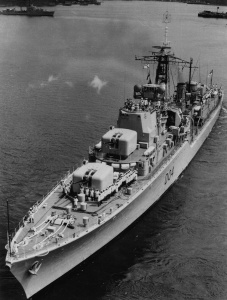
From India, Voyager (II) took passage east, back to Singapore, for a self-maintenance period, 30 March-12 April. This enabled outstanding defects to be made good, including boiler cleaning and exchanging the Asdic dome; the latter being achieved without docking the ship.
In the sporting field, the ship defeated Melbourne (II) at Aussie Rules, and so became the Fleet Champion at that sport.
On 13 April, Voyager (II) joined Melbourne (II), Queenborough (I) and her sister Daring, Vendetta (II), for passage to Subic Bay, with a full programme of exercises undertaken as part of the Australian Fleet Efficiency Competition. A Fleet Sports Day was held aboard Melbourne (II) en route, with teams from other ships transferring by jackstay. At the end of an enjoyable day, Voyager (II) came a well deserved second in the final placings.
Various exercises took place in the Subic Bay exercise areas, including anti-submarine (A/S) exercises against the US nuclear submarine, Sargo. The submarine provided a real challenge for the ship’s A/S team, taking violent evasive action and making full use of bubble decoys. Voyager ’s sonar operators found that they had to only be briefly deceived by these decoys before the elusive submarine was outside sonar range.
The next operational event for Voyager (II) was the Exercise PONY EXPRESS in the South China Sea, 22 April-4 May, where she was one of four RAN units participating. For those who like statistics, SEATO Exercise PONY EXPRESS involved 60 warships, 20,000 naval personnel and 6000 US, British and Australian troops. The exercise saw RAN ships successfully escorting an international Amphibious Task Force from Manila to British North Borneo against attacks by a US nuclear submarine.
Friday 5 May was a ‘red letter day’ for Voyager (II), when she handed over her duties in the Strategic Reserve to Vendetta (II), and then sailed, in company with Royal Navy ships to Hong Kong for one last visit. The force entered Hong Kong on 8 May, and Voyager (II) berthed at Victoria Basin for two week’s self-maintenance, including preparation for the annual Admiral’s Inspection. FOCAF, Rear Admiral Harrington carried out his inspection on 17 May.
During the night of Wednesday 17 May warning was received of Typhoon Alice 450 miles south of Hong Kong, with all indications that the centre might pass close to the Crown Colony. Voyager (II) and Melbourne (II) were ordered by FOCAF to proceed to sea, the flagship sailing without 300 of her crew.
Once at sea course was set to the eastward, and the ensuing 24 hours was spent manoeuvring to keep clear of ‘Alice’. The eye of the storm passed across Hong Kong during Friday 19 May, with winds of 85 knots being recorded. Melbourne (II) and Voyager (II) re-entered harbour on Saturday morning.
The ship’s final weekend in Hong Kong was used by the ship’s company for last minute shopping. This was followed by the task of finding secure stowage for the various dinner sets, tape recorders, bicycles, pedal cars, tricycles and scooters, etc, that had found their way onboard.
Voyager (II) departed Hong Kong on Tuesday morning, 23 May 1961, and undertook a successful torpedo firing at the East Ninepin Rock. The ship then rendezvoused with Melbourne (II), and course was set to make the San Bernardino Strait route through the Philippines, en route to Manus Island. Voyager (II) was briefly detached to Subic Bay, to pick up a Melbourne (II) sailor who had been hospitalised. On rejoining the flagship, the sailor was transferred by highline.
For Voyager (II), events during the passage included a 24 hour economical steaming trial, which saw the ship attaining a fuel consumption of 6.46 miles per ton of FFO. The ship also exercised a tow aft, with Voyager (II) towing Melbourne (II) across the Equator at 6½ knots. From the ROP for May 1961:
On completion of this exercise, Voyager (II) refuelled from Melbourne (II), the run being a timed one for the Fleet Efficiency Competition. Voyager (II) clocked exactly 4 minutes from the waiting position to start pumping, and in doing so gained another Australian fleet record. Voyager (II) also claims the Far East Station fuelling record...with total dead time of 6 minutes for fuelling from a fleet tanker, ie. from 2 cables to start pumping and from stop blowing through to disengage.
The Navy News of Friday, 21 July 1961 included a list of Naval personnel who had been advanced in rate effective 5 May 1961, including the following Voyager (II) sailors:
Voyager (II), in company with Melbourne (II) paid a short visit to Manus on 1 June, mainly for fuel, but several sporting matches were played against HMAS Tarangau during the stay. This was followed, on 3 June, by a one day visit to Rabaul, where there was a full sporting programme, with the local teams providing good opposition. Both ships were open to visitors, with local residents taking full advantage of the occasion.
On passage south from New Britain, the torpedo firing section of Voyager (II)’s Torpedo Anti-Submarine Test was carried out, with two torpedoes with blowing heads being fired at Melbourne (II); a hit was claimed with one torpedo.
Off Townsville on 7 June, Melbourne (II)'s North Queensland libertymen were transferred to Voyager (II) by boat, following which the ship berthed at Townsville to disembark ‘passengers’ and refuel. While ‘up top’, Voyager (II)’s Welfare Committee had purchased a large quantity of toys for the St George Home for Children at Rockhampton. These were landed at Townsville to be forwarded to the Children’s Home.
With the ships anchored in Moreton Bay on Sunday 11 June, Melbourne (II)’s libertymen were transferred to Voyager (II), which then proceeded upriver to Brisbane, where the ship, and the disembarking ‘passengers’ were greeted by a large crowd, a battery of local press and TV crews.
On passage south to Sydney, Voyager (II) detached and proceeded independently for Sydney, where, in Watsons Bay on 13 June, she embarked a team from HMAS Watson for the ship’s Action Information Organisation Efficiency Test. Concurrently with this, an anti-aircraft sleeve firing was carried out, which resulted in a direct hit on the sleeve.
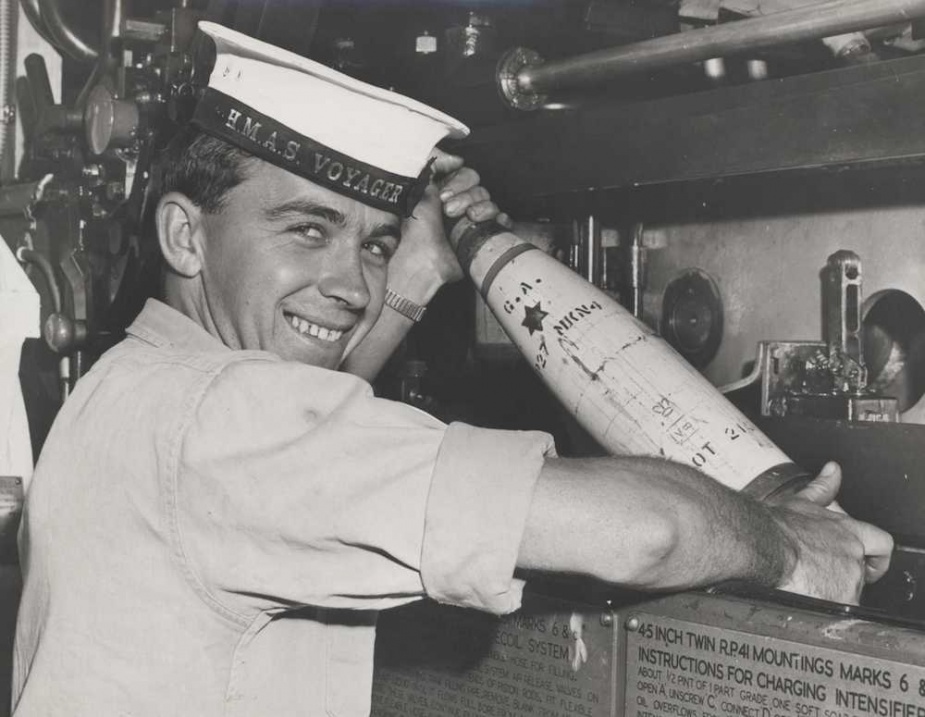
Voyager (II) anchored in Jervis Bay on 14 June, sailing with Melbourne (II) and Quiberon (I) the next day for a Ceremonial Fleet Entry into Sydney. Rendezvous was made with other fleet units off North Head where the fleet formed up for the entry. Ships taking part were Melbourne (II), flying the Flag of FOCAF, Voyager (II), Vampire (II), Quiberon (I) , Quickmatch (I), Parramatta (II), Swan (II), Warrego (II), Barcoo (I), Kimbla (I), HM Submarines Tapir and Trump , plus SDB 1327 and two Air-Sea Rescue Craft. From Voyager (II)’s ROP:
The weather was bright and clear and there were many spectators. On passing Bradleys Head, Melbourne (II) hauled out of line, and the fleet steamed past with Senator Gorton (Minister for the Navy, aboard the Flagship) taking the salute. Voyager (II), continuing past Melbourne (II), led the remaining ships of the fleet under Sydney Harbour Bridge and round Cockatoo Island. Voyager (II) returned to Garden Island berthing at Cruiser Wharf where the families and friends of the ship's company were waiting to greet the ship on its return from the tour of duty with the Strategic Reserve.
Voyager (II) was de-ammunitioned on Monday 19 June, and commenced long refit the following Monday. Like other fleet units, on 10 July 1961, Voyager (II) celebrated the Royal Australian Navy’s 50th Anniversary with a ‘splice the mainbrace’ and free beer issue.
The Navy News of Friday 29 September 1961 included a list of personnel who had been advanced in rate effective 11 August 1961, including the following Voyager (II) sailors:
Navy Week in the RAN’s 50th Anniversary year was celebrated in early October, in conjunction with Sydney’s Waratah Festival. Voyager (II) was alongside at Garden Island. Being under refit, she was not open to the public but took part in the Saturday Open Day by firing her anti-submarine mortars.
Voyager (II) emerged from her four month refit on 1 November 1961, sailing to the Jervis Bay Exercise Areas for a strenuous workup, then proceeded to Melbourne on completion just in time for the activities of Melbourne Cup week.
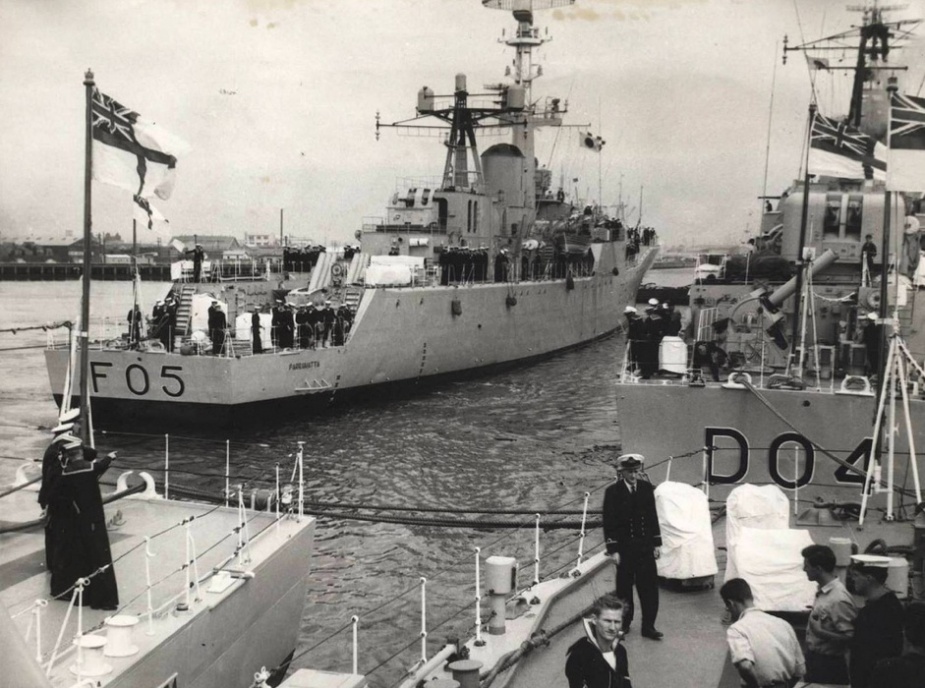
Exercise AUCKEX 6 was next on the agenda, 10-26 November 1961, involving three British, two New Zealand and five Australian units. HMAS Voyager (II), under the Command of Captain DC Wells headed the RAN task group. AUCKEX was an extensive two-phase exercise commencing on the east coast of Australia and ranging across the Tasman Sea. On completion of the exercise visits were made to Lyttleton and Auckland.
During the New Zealand cruise, whaler pulling races were held between the Battle Class destroyer Anzac (I) and Voyager (II), to decide which ship would be the Fleet Pulling Champion, or ‘Cock o’ the Fleet’. Auckland was decided as the venue for this display of wind and muscle coordination and the cheers and abuse of those doing all the work.
From Navy News:
It is suspected that an intensive 48 hour programme of dedicated training lasting well into the wee hours went on from each ship prior to the race. Each ship when asked was emphatic that no crews had been together in the boat before, as there hadn’t been time! (Would somebody please pass the grain of salt?) The pride of both ships, the seamen’s crew, were the first away, with Anzac (I) proving too strong at the end. Voyager (II)’s boys, over-keen, spent the half hour before the race training hard. This did not improve their stamina and Anzac (I)’s crew pulled very well to draw away and win by two lengths. In a slightly lighter mood the Wardroom crews next joined battle. Almost at once the mood changed for Anzac (I) as Voyager (II)’s crew pulled steadily away and held off a timely challenge without much difficulty. The Score was one each. Anzac (I) started favourite again for the Communication and Electrical race. Once again the crews were of a high standard and there was little between them. A missed stroke in Anzac (I) then put Voyager (II) ahead, and she managed to win by a quarter of a length. The engine room followed in a slow race. Neither boat conceded more than half a length at any stage, and as they approached the finishing line it was obvious that a photo finish would be necessary to separate them. A dead heat was pronounced until the photograph was processed. Thus the miscellaneous crews’ race was to prove most important. Fortunately for Voyager (II) this was our strongest crew and the race was in our keeping right from the start. So Voyager (II) became the new champion.
Voyager (II) returned to Sydney on 8 December 1961 for a welcome Christmas leave period.
The ship commenced 1962 alongside Garden Island Dockyard for leave and self-maintenance. Her operational year started on 13th January when she left the delights of Sydney and sailed south to the Jervis Bay Exercise Areas for a strenuous workup prior to what seemed to be her annual deployment 'up top' to the Strategic Reserve. Prior to the deployment, Voyager (II) and HMAS Queenborough (I) shared an enjoyable family day at sea.
Voyager (II) with Queenborough (I) in company sailed from Sydney on Monday 5 February 1962 for passage to the Jervis Bay Exercise Areas. On Thursday 8 February, the retiring First Naval Member of the Naval Board, Vice Admiral Henry Burrell, bade farewell to the fleet, anchored in Jervis Bay for the occasion. During Thursday forenoon, the combined ship's companies of the Flagship, Voyager (II) and Queenborough (I) attended Divisions aboard Melbourne (II) to mark the retirement of Admiral Burrell.
Voyager (II)’s next port of call was Hobart for the Fleet Pulling Championship, which took place on Saturday 10 February. Whaler crews from each of the ships present, Melbourne (II), Voyager (II), Queenborough (I) and Anzac (I), competed. Anzac (I)’s team were determined to redeem the ‘temporary’ loss of the ‘Cock o’ the Fleet’ trophy which Voyager (II) had won in late 1961. Unfortunately for Voyager (II), Anzac (I)’s crews were too strong on the day, and the ship’s recently acquired trophy departed in a moving handing-over ceremony. The ship had to make do with the consolation prize of her team, combined with that of Queenborough (I), beating Melbourne (II) in water polo.
Task Group 327.2 ( Melbourne (II), Voyager (II) and Queenborough (I)) next paid a brief visit to Adelaide, then passaged across a stormy Great Australian Bight to Fremantle, en route to Singapore.
This was the era of ‘Confrontation’ between Indonesia and Malaysia, over the creation of the Federation of Malaysia, formed by the union of Malaya, Singapore, North Borneo and Sarawak. Indonesia objected strongly to the new state, resulting in acts of aggression by that country in the period 1962-66. As part of the larger British and Commonwealth forces, Australian Navy, Army and Air Force units were involved in the campaign to defend the newly established Malaysia against confrontation by Indonesia.
As early as 1961, Indonesia had threatened to block the right of free passage through the waters of the Indonesian Archipelago. Task Group 327.2 challenged this right en route to Singapore, with the ships passaging through the Sunda Strait on 6 March 1962, with their ship’s companies closed up, and aircraft at readiness on Melbourne 's flight deck.
The Task Group arrived at HM Dockyard , Singapore, on 8 March 1962, with the ship's companies of the visiting ships soon discovering the Fleet Club and other messes at HMS Terror , with their excise-free drinks.
Voyager (II)’s crew had been busy on the passage northwards. Navy News reported:
Take one First Lieutenant; crease his brow with a worried frown...take the remainder of the ship’s officers, supply them with white overalls (there are no other colours), and stick a paint brush in their hands. Take the sailor: coax him, bully him...Take a sense of humour; stretch it, bend and warp it, but never lose it. Take one August Personage, one in whose presence Angels fear to tread, and who sits in judgement over us. Mix all the above together into one mad potpourri and simmer well under a hot tropical sun. The result: Admiral’s Inspection.
This took place on Friday 9 March, when the Flag Officer Commanding Her Majesty’s Australian Fleet inspected Voyager (II)’s ship’s company, and conducted the ship’s Annual Inspection.
The Navy News of Friday 23 March 1962 included a list of personnel who had been advanced in rate effective 9 February 1962, including the following Voyager (II) sailors:
Following only a short visit to Singapore, Voyager (II), with Melbourne (II) in company took passage to Hong Kong on Monday 12 March. Voyager (II)’s Atomic, Biological, Chemical Defence and Damage Control, and Electrical Inspections were carried out during the passage.
The latter half of March was an enjoyable time for Voyager (II), with the period 16-30 March spent in Hong Kong for self-maintenance. As usual, it seemed that the berthing lines were hardly secure before the customary trader’s ‘bazaar’ had been set up onboard. Navy News reported:
Hong Kong has proved to be the usual magnet for all onboard with flashing neons and a twinkling fairyland of lights in the hills at the back of the city. Things have begun to quieten since Jack realised that a hundred dollars was not just a hundred pieces of paper but eight hard earned Australian pounds. Also that eight pounds doesn’t go quite as far on beer and entertainment up here as it did down south. The price of the national drink is about two shillings a middy...But the Colony has its brighter side with most manufactured goods at bedrock prices. Fr’instance a Bespoke tailored suit for a miserable fifteen pounds takes a lot of tossing. A Charlie Farrow suite, Rolex Oyster watch, plus the big camera complete with accessories are definitely de rigueur for the meandering matelot.
While in the Crown Colony, Voyager (II)’s cricketers enjoyed a match against the Hong Kong Wanderers at the attractive little Hong Kong Cricket Club ground, defeating the home team by nine runs. To prove that it wasn’t a fluke, they then downed a challenge team from Melbourne (II) to win the fleet trophy!
Voyager (II) left the delights of the Crown Colony on 30 March to the sound of good luck Chinese firecrackers set off by Jenny’s Side Party, on passage across the South China Sea to Subic Bay, in company with the Flagship and Queenborough (I).
Subic Bay was visited on 2-3 April, with Voyager (II) berthing alongside USS Whitehurst . The opportunity was taken to liaise with the US Navy at all levels, aboard their ships, ashore and at sport. Much has been written about the Americans, but their generous hospitality leaves nothing to be desired.
The following Navy News item provides sporting highlights of the ship’s visit:
During our first stay of two days in the large US Navy base at Subic Bay; Voyager (II) commenced tug-o’-war training. On the first day the Seamen’s team thrashed the Stokers in a fashion which fascinated our American friends. USS Rogers had already challenged us to a game of softball, which we were none too confident of winning, so we threw down the gauntlet for a tug-o’-war contest. At 16:00 a big crowd of Australians and Yanks were on the wharf to witness the struggle. The Americans produced a very heavy team but lacked the technique of our boys who, under the expert coaching of PTI ‘Re-Bob’ Golotta, won in two straight pulls. The Americans were willing for another try and now produced eight ‘giants’ from their underwater demolition team. They had never been in a tug-o’-war before but looked disgustingly strong and fit - and in the first pull heaved our boys over the mark by brute force. The second and third pulls were thrilling ones with neither team giving an inch until Voyager (II)’s superior technique won the day amid roars of approval from the now large crowd...The result of the tug-o’-war with those Yank divers was a football match - what a game! Originally the idea was to play one half rugby and one half ‘gridiron’, but eventually it was decided that the American game was too complicated for a ‘picnic match’, so a full rugby game was played - if it be right to call what ensued rugby! The Aussies did receive a few lessons in the American game and had some practice ‘forward passes’ with the pocket-sized ball. After the Americans had received a quick explanation of the game and rules of rugby, Voyager (II) kicked off in the middle of a tropical downpour which was to last throughout the ‘match’. The ball was impossible to hold from the start, and with the players wearing sandshoes instead of boots, they found it most difficult to remain upright. There resulted one of the funniest events ever to take place on a football field, with nobody taking much interest in the rules, and even less in the result! But it must go on record that the Yanks eventually won 6-3, proclaiming this was the greatest game they had ever played. In short, they enjoyed it.
Exercises in the local exercise areas took place on 4-5 April, following which Voyager (II) detached to proceed to Tacloban, at the northern end of Leyte Gulf. En route, the ship hove to for a short service to commemorate the personnel killed aboard the cruiser HMAS Australia (II) during the Battle of Leyte Gulf in October 1944.
Voyager (II) was the first RAN ship ever to make an official visit to Tacloban. Insufficient depth of water alongside the jetty meant that the ship had to anchor offshore. When the ship’s official party reached the wharf, they were welcomed by a brass band and a contingent of pretty girls who draped leis over the visitors, following which they went in an official convoy to the Governor’s residence, where the Captain was presented with the keys of the city. Even the ship’s ROP mentioned that it was a welcome never to be forgotten. Voyager (II)’s Navy News correspondent wrote:
Meanwhile back onboard, the sailors were fighting to donate blood in the for’ard cafeteria. Of course the sailors’ intentions were purely humanitarian, but it is felt that the sight of the charming Red Cross nurses helped to encourage them...By lunchtime the girls had run out of containers before they ran out of willing donors. Two more official parties, one of Chiefs and Petty Officers, and one of junior rates, landed during the day to receive a further taste of the local hospitality. The Filipino children seemed to benefit most of all, as after a couple of hours one could see them...begging that they just could not eat any more ice cream or drink any more ‘Pepsis’. It was a wonderful afternoon for Taclobans and Aussies alike, and a group of matelots even made a tape at the local radio station.
The multi-phase SEATO Exercise SEA DEVIL, 16 April-4 May, was the Australian task group's first major exercise. The exercise which involved 47 ships, 150 aircraft and 16,000 personnel from Australia, Britain, New Zealand, Pakistan, Thailand, the Philippines and the USA, was directed by Rear Admiral McNicholl, RAN, aboard the carrier Melbourne (II). The other RAN units involved in SEA DEVIL, SEATO’s 21st maritime exercise, were Voyager (II), Vendetta (II) and Queenborough (I).
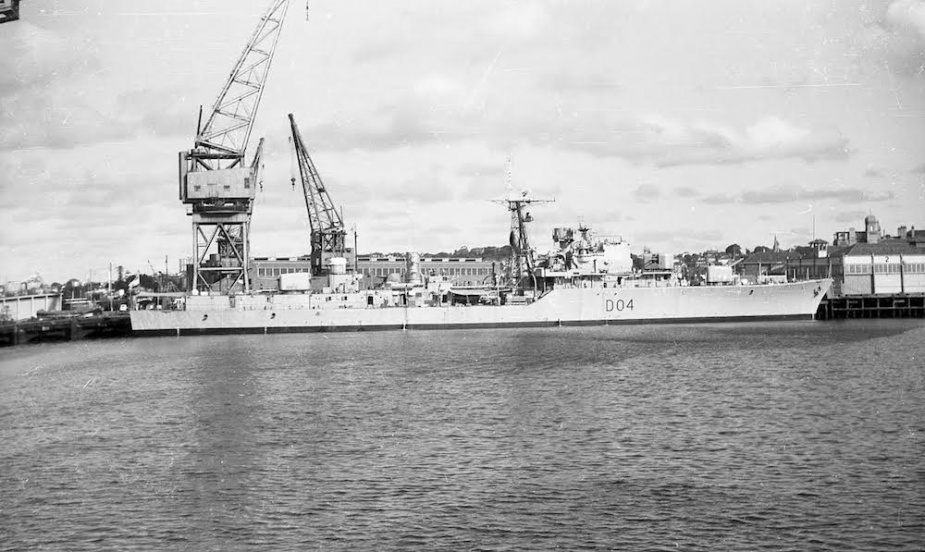
Note: This video is hosted on YouTube. Department of Defence users will not be able to view this video on the Defence Protected Network. This cine film has been placed online as part of the Sea Power Centre - Australia's ongoing archival digitisation program.
Download video transcript.
Voyager (II) took on a mainly anti-submarine role during SEA DEVIL. In the prevailing calm conditions, her 978 radar achieved excellent results in detecting periscopes and snort masts, and thus initiating action against the underwater opposition. Someone espoused the theory that perhaps the most interesting part of these exercises was the ‘wash-up’, where the exercise was refought around the conference table with the usual “I told you so’s” and “But we couldn’t have possibly been in that position...”.
The Navy News edition of 11 May 1962 announced to its readership that during the current cruise, Voyager (II) had nine ‘new’ fathers aboard her crew. The Navy’s newspaper also made known that, the ship, in the first timed jackstay transfer run of the 1962 Fleet Competition, had created a new record of 3 minutes 46 seconds. HMAS Yarra (III), the new anti-submarine frigate that had just joined the task group, made it known that she was keen to beat Voyager (II)’s jackstay transfer record. Not to be outdone, during the passage Voyager (II) beat her own record again, with a jackstay transfer time of 2 minutes 44 seconds, and for fuelling, a time of 3 minutes 5 seconds from first gun to pumping.
Following Exercise SEA DEVIL on 7 May, the RAN task group, now consisting of Melbourne (II), Voyager (II), Vendetta (II), Yarra (III) and Parramatta (III), departed the Philippines, en route to Japan for a goodwill visit taking in several ports over a three week period. At the time, this was the biggest group of RAN ships to visit Japan.
And so to Japan, commencing with a visit to Nagasaki, in company with Vendetta (II). Navy News provided this comment:
Take a couple of thousand Australian sailors. Dress them up in their best blue suits, put a few shekels in their pockets, and then let them loose on the unsuspecting population of some foreign seaport. What a devastating effect it must have; but the residents of Nagasaki were equal to the occasion, and promptly raised the prices of their merchandise...
Nagasaki had been completely rebuilt from the devastation of World War II. At that time it was a small city not normally visited by many tourists, which meant that few of the inhabitants spoke English. Voyager (II)’s Navy News correspondent noted that:
...a lovely Japanese home overlooks the entrance to Nagasaki Harbour and is popularly known as Madame Butterfly’s House. The world's largest ship-building yard operates here, and was certainly an eye-opener to see so many ships on the stocks, all being built remarkably quickly. A day at Unzen National Park with its thermal springs completed our visit, which included lunch at a Japanese inn.
On Tuesday 15 May, Voyager (II), in company with the other task group ships, proceeded from Nagasaki on passage through the Shimonoseki Strait and the Inland Sea to the port of Kure. Apart from the numerous small fishing boats intent on blocking the shipping channel, the passage was uneventful, with Voyager (II) berthing outboard of Yarra (III) and Parramatta (III) at 10:05 on 16 May. During the visit, train trips to Hiroshima were popular. Hiroshima was now the ‘City of Peace’. Following World War II, the city had thrived, having been nearly totally reconstructed, almost totally erasing all signs of the atomic bomb that devastated the city, except for the ‘A’ Bomb Museum and Park. There were also trips to the sacred island of Miyajima, with transport provided by Japanese Navy landing craft, so sailors on this excursion travelled under the Japanese ensign. Miyajima is sacred to the Japanese, with its magnificent Tori Gate, and beautiful temples and shrines in abundance.
Following an overnight passage from Kure, a goodwill visit to Kobe was next on the agenda, 16-18 May. Kobe, being Japan’s second largest foreign trading port had much to offer in the way of tourist attractions, including the traditional Japanese bathhouses. The shopping facilities, especially the large Dia Maru store with its large range of merchandise, its cleanliness and the courtesy of its staff was first rate, and much shopping was done, in spite of the high prices. From the pen of Voyager (II)’s Navy News ‘scribe’:
Our four days in Kobe went all too fast, for this port undoubtedly had the most to offer. As well as the excellent shopping (the mess decks became full of marvellous toys running over decks and tables), there were many fascinating places to visit in and around the city. Coming quickly to mind is the glorious view from Mt. Nikko, historical features of Kyoto and Nara, and the busy life of Osaka. But the highlight for everybody who saw it was at Takarazaka, a village 20 miles from Kobe. It is doubtful whether a better stage show can be seen anywhere in the world than the famous Takarazaka Girls’ Review - who could complain about 150 girls on stage at the same time! Both Japanese and foreigners are thrilled by the flawless presentations of traditional Japanese opera and modern musicals.
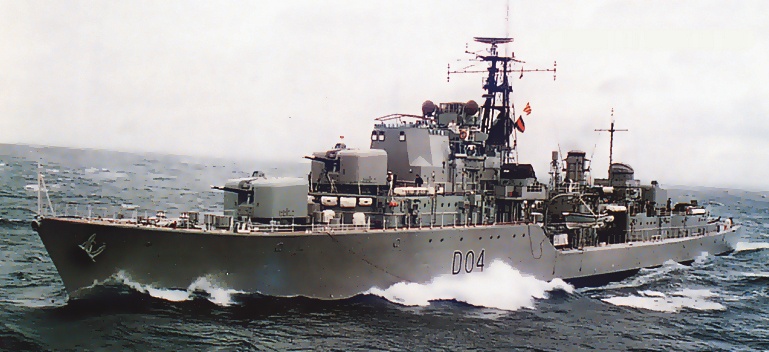
On Wednesday 23 May, Voyager (II) slipped and made passage to Yokohama, Japan’s largest port and the gateway to Tokyo, in company with the other ships of the task group, berthing alongside on Friday 25 May. The British communities of Tokyo and Yokohama had arranged entertainment for the ship’s company, in addition to the numerous bus tours which were very popular and always full. From the ship’s Navy News reporter:
Tokyo’s nightlife is as famous as that of Paris, but the night clubs’ prices are far beyond the resources of Australian sailors. From Yokohama to the Hakone National Park is a 3½-hour bus ride through beautiful country. Mt Fuji is in this national park, and adds to the already glorious scenery about the lakes.
The Task Group sailed from Yokohama on 30 May 1962, and once clear of Tokyo Bay, the ships made rendezvous with the RFA Fort Charlotte to replenish with provisions. On completion, the two frigates detached to Hong Kong, with the remainder proceeding southwards to Guam.
Voyager (II)’s ROP for May 1962 summarised the visit to Japan by saying:
The visit to Japan was a most enjoyable experience...Bus and train tours (not ordinarily well patronised by sailors) were taken enthusiastically...Not only were the ship’s company well received ashore by the common people, but a number were invited into Japanese homes. Large numbers of the Japanese were sufficiently interested in the Australian ships to make rather tedious journeys to visit them on open days. It is difficult to believe that there could be a more effective way of spreading Australian national goodwill directly and personally to many thousands of Asian people than by a visit of this kind, nor that there could be a better way of broadening the outlook and understanding of the young sailors fortunate enough to be involved.
The ship’s Navy News reporter wrote:
...a quick sum up of our impressions is of a beautiful country, with excellent facilities for the tourist, whose people are clever, industrious and have made use of advantages of the modern world without losing their love for old traditions - and, most of all, oh such beautiful women.
A somewhat ‘tongue in cheek’ report in Navy News had this to say:
Doesn’t the tendency to ‘go native’ grow on you in a very short time? Even after the first day crewmen could be seen around the ship bowing to one another...accompanied by the proper intake of breath through clenched teeth. The politeness of the people was almost overpowering. Some incidents noted included: the train conductor on entering the carriage to check tickets, lifts his cap, addresses the passengers “Good afternoon, ladies and gentlemen. May I see your tickets, please?” The pretty girls standing beside the bottom of the escalator bow and murmur “Thank you for riding on my escalator”. The shop assistant bows before accepting your money and thanks you “for making a purchase at my counter”.
The Navy News of 22 June 1962 included a list of Naval personnel who had been advanced in rate effective 4 May 1962, including the following Voyager (II) sailors:
On passage to Guam, a sports day was held aboard the flagship with the following teams competing: Melbourne (II), Melbourne Air Group, Vendetta (II) and Voyager (II). The teams thoroughly enjoyed themselves, as did the spectators, and the broadcast of the afternoon’s events was also enjoyed.
Monday 4 June saw the ships at Guam for a short visit. The local US Services entertained the ship’s company at all levels, in their clubs, in sightseeing, and at sports. The sailors discovered that for once, they could freely exchange their Australian pounds for dollars, and converged on the US Services PX Store for one final shopping spree.
Following the task group’s departure from Apra Harbour, Guam, the flagship’s two consorts were detached: Vendetta (II) to proceed ahead to Manus, and Voyager (II) to make an independent goodwill visit to Ladava, Milne Bay, and Samarai.

A few miles from Samarai, the ship’s whaler was slipped and proceeded inshore with the object of making last minute arrangements for social and sporting activities, while the ship anchored off Ladava at the entrance to Milne Bay at 06:30 on Tuesday 12 June. During the day Voyager (II) embarked boatloads of native children from the missions and local villages, and steamed around Milne Bay, impressing her passengers with a pyrotechnics display and firing the anti-submarine mortar was fired. As a finale, the young visitors enjoyed fizzy drinks and cakes, before disembarking. The ship, in turn, enjoyed the hospitality of the local European community at Samarai that evening. On Wednesday forenoon, with more children onboard, Voyager (II) provided a repeat of the previous day’s activities, before sailing south through China Strait to rendezvous with Melbourne (II) and Vendetta (II).
Following the visit to Samarai, District Commissioner Clifton-Bassett sent a thank you signal to Voyager (II), expressing the deep appreciation of the residents. Similar thank you letters were also received from the Catholic Missions whose children had enjoyed Voyager (II)’s hospitality.
Long leave libertymen were landed at Townsville and Brisbane en route to Sydney, where the ships arrived on Thursday 21 June. When Voyager (II) secured alongside the Oil Wharf she was greeted by an enthusiastic crowd of several hundred friends and relatives.
The period 21 June to 17 October 1962 was spent in refit, with the ship alongside Garden Island Dockyard.
The Navy News edition of 24 August 1962 announced the initial intake of Upper Yardmen at the Royal Australian Naval College, Jervis Bay; a scheme that provided an avenue for selected ratings to obtain permanent general list commissions in the RAN. The initial intake included two sailors from Voyager (II): Electrical Artificer RD Cole, and Radio Electrical Mechanic K Zarubin.
Voyager (II) emerged from her refit in mid-October. With a new Commanding Officer, Commander AA Willis, and an almost complete change of ship’s company, she put to sea on 18 October for post-refit trials and the usual exhaustive, and exhausting, workup programme.
In late October, Voyager (II) took part Exercise SEASCAPE, a SEATO exercise designed to evaluate the naval control of shipping. For the remainder of 1962, the ship was mainly involved in exercises in the Jervis Bay exercise areas, alternating this with short maintenance periods in Sydney. Voyager (II)’s year finished alongside Garden Island Dockyard for leave and maintenance.
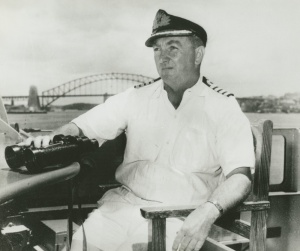
For Voyager (II), 1963 commenced with a Change of Command ceremony onboard, with Captain DH Stevens assuming Command from Commander Willis on 2 January.
On 21 January, in a simple ceremony aboard Voyager (II), the ashes of the late Commodore JC ‘Copper’ Morrow were scattered at sea. Voyager (II) was chosen for the task because the previous ship of the name had been commanded by Commodore Morrow on the Mediterranean Station during the World War II. The service was held off Sydney Heads in a position close to the Chapel of St George the Martyr at HMAS Watson , where the Commodore’s funeral service had been held.
Exercises in the Jervis Bay exercise areas during January included a successful gunnery shoot, plus anti-submarine training against one of the Royal Navy submarines of the Fourth Submarine Division based at HMAS Penguin .
The last week of January saw the ship alongside Garden Island preparing for her sixth and final deployment ‘up top’. Voyager (II)’s final social engagement before departure took place on Friday 25 January, with an official reception on the fo’c’sle. Guests included Rear Admiral Gatacre, Mrs Gatacre, and Captains of RAN ships in harbour. On 31 January, in company with Vampire (II), Voyager (II) departed her home port, bound for South East Asia and the Strategic Reserve.
The two ships called into Darwin briefly en route, 7-8 February, with Voyager (II) berthing on Vampire (II) at Stokes Hill Wharf. This was a visit that was very much appreciated by the several ‘territorians’ amongst the crews. Voyager (II) was challenged at Rugby Union by the RAAF, with the Air Force team proving too strong on the day. HMAS Coonawarra very kindly allowed the ships to use its sporting and mess facilities. It was even said, ‘tongue in cheek’, that Coonawarra was carrying out its prime duty of acting as a social club for the Navy’s hardworking seafarers!
Two days out of Darwin en route to Singapore, the two ships came under the operational control of Flag Officer Commanding-in-Chief, Far East Fleet (C-in-C FEF). Intership quizzes were held during the passage. The usual beard growing competition had commenced on departure from Sydney, producing a field of varying colours and some magnificent failures who had to start shaving again before being allowed ashore in Singapore.
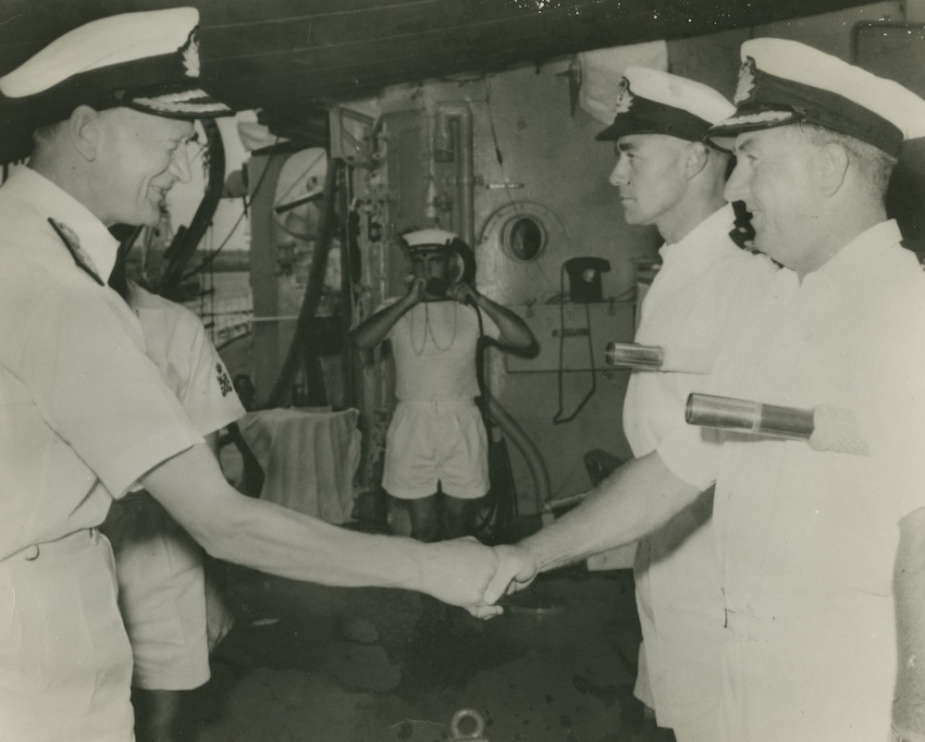
Voyager (II)’s seventh birthday was celebrated on 12 February 1962 with a special birthday cake baked by Petty Officer Ck Dick Norman and L/Ck (O) Ron Conway. The next day Voyager (II) and Vampire (II) berthed at the Naval Stores Basin, HM Dockyard, Singapore, relieving the ‘Q’ Class frigates, Queenborough (I) and Quiberon (I) as Australia’s contribution to the British Commonwealth Strategic Reserve. Divisions and Prayers for both Darings were held onboard Voyager (II) on Sunday 17 February.
There was a full sports programme while the two ships were in Singapore, with a variety of sports being played most evenings using the facilities at HMS Terror . Voyager (II)’s Navy News correspondent reported that:
Possibly one of the greatest games of rugby union I have seen was played between Vampire (II) and Voyager (II), at HMS Terror ...Tribute must be paid to the two coaches, Mech Gil Shephard of Vampire (II), and Sub Lieutenant Dowling of Voyager (II). Vampire (II) were winners by 11 to 8, and at no time could I ever guess what the result would be.
On 25 February, on completion of a self-maintenance period, Voyager (II) cast off from the Naval Stores Basin, and accompanied by Vampire (II), proceeded down Johore Strait. While still in Johore Strait, Voyager (II) landed a sick sailor, using a ship’s boat, then rejoined Vampire (II). The two ships then joined the Royal Navy destroyer, HMS Caesar , on passage to Trincomalee, Ceylon.
The crews of the two Darings berthed at the Pepperpot Jetty, Trincomalee on 1 March 1963. A comprehensive social and sporting programme had been arranged, and generous hospitality was offered by the local European community. Highlights of the visit included visits to Colombo and Kandy.
Following their visit, the ships cast off and passaged east back to Singapore, taking part in Exercise JET 63 en route. On 16 March, following the exercise, the two Darings berthed at the Naval Stores Basin at HMS Terror .
In late March, they took passage to Hong Kong, as part of a task group led by the carrier, Melbourne (II). The RAN flagship, together with the new fleet oiler, Supply (I), and frigates Yarra (III) and Parramatta (III) had just commenced a two month deployment.
The task group arrived in Hong Kong on 29 March, with Voyager (II) commencing a two week self-maintenance period, assisted, of course, by a small army of Chinese labourers, ie, Suzie’s Side Party. Higher Rates Boards were conducted during the first week of April. A small party from the ship enjoyed a guided tour of the San Miguel brewery, which had been arranged by the Australian Association. The Ship’s Company Party was held on Wednesday 10 April, at the China Fleet Club. Entertainment was provided by a very talented Chinese group that included a small combo, a juggling act, an acrobatic group, two magicians, and as the ship's Navy News ‘scribe’ reported:
...an Exotic Dancer, to take our minds off the magic of the conjurers. The evening went off well, and, by the look on the faces on Thursday, all enjoyed it.
Voyager (II)’s sporting teams were busy during the stay, with the ship’s water-polo team defeating Parramatta (III), 9-7, in HMS Tamar ’s new pool. Voyager (II) also beat Parramatta (III) at soccer, while a combined Voyager (II)/ Vampire (II) cricket side defeated the combined Royal Navy Ships team by 98 runs.
The ship’s landing party made full use of Stonecutters Island, proving that sailors are just as adept at using small-arms as they are at using 4.5-inch and 40mm guns.
An Open Day was held during the visit, during which an incredible 12,000 people swarmed over the ship!
On 15 April the RAN task group sailed from Hong Kong on passage south to Singapore, where an impressive Fleet Entry was made on 21 April. During their short stay in Singapore, 21-23 April, preparations were made for the SEATO exercise, SEA SERPENT. This multi-phase international exercise took place in the South China Sea during late April/early May.
Following the arduous work up phase of the exercise, Voyager (II) and several other units anchored off the small island of Pulau Tioman, on Saturday morning, 27 April, for a weekend ‘Banyan’. From the pen of her Navy News ‘scribe’:
Saturday proved to be a beautiful day and the beaches were packed both with sailors and the local children selling bananas and coconuts. Quite often the coconuts were sold in the husk, and it was amusing to the natives to see the sailors struggling to remove the husks from them...On Sunday, Bar-B-Que hampers were packed, and our Banyan parties landed in force with a great array of sporting equipment...Congratulations must go to Bob Claridge and Butch Verco for the job well done in the culinary department.
According to Navy News, the main phase of Exercise SEA SERPENT saw the ships “assailed by subs, planes, missiles and atomic attacks while standing closed up continuously in three watches, before escorting the largest convoy most of us had ever seen into Manila Bay.” Voyager (II)’s many tasks during this 10 day exercise included convoy screening, rescue destroyer and surface attack unit.
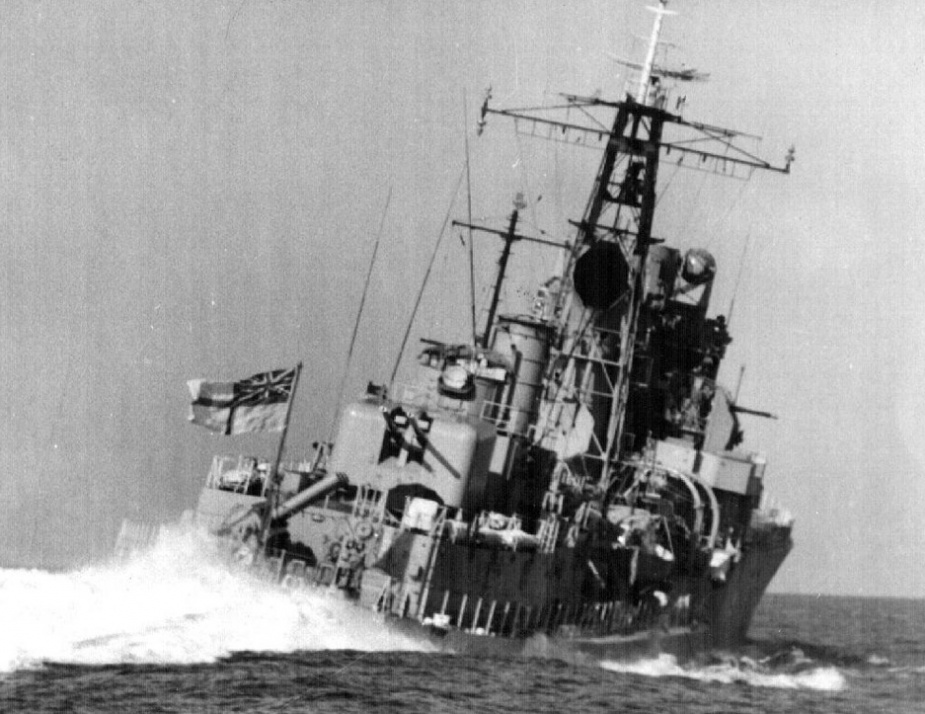
The post-exercise critique and a short visit to Manila followed. Then, as part of a Royal Navy task group, Voyager (II) and Vampire (II) passaged across the South China Sea for another visit to Hong Kong, 13-20 May. During the visit, Voyager (II)’s ship’s company donated blood to the local Red Cross. At this time, the British Crown Colony’s water reserves had been seriously depleted due to lack of rain, so to prevent a further drain on supplies, visiting ships were ordered to raise steam and use onboard water distilling facilities. It was even rumoured that the brewery would be closed to conserve Hong Kong's dwindling water supply.
Hardly a highlight, but during the visit, 13-20 May, Voyager (II)’s ship’s company was landed to test their respirators in HMS Tamar ’s gas chamber.
Voyager (II)’s postman, LRO Graham Broom, even featured in Navy News when it revealed that during the visit to Hong Kong, while just 30 pounds of inward mail was received, the ship’s company sent 85.5 pounds of outward mail.
With Hong Kong, as usual, having annihilated the ship’s company’s savings bank accounts, Voyager (II) sailed on Monday 20 May, in company with HMS Lion , flying the Flag of (C-in-C FEF); HMNZS Royalist , HMS Caesar , and HMAS (Vampire). After leaving Hong Kong, Voyager (II) carried out a successful torpedo firing at the East Ninepin Rock. For many of the ship’s company, this was the first time they had witnessed the spectacular explosion of a ‘live’ torpedo.
Later that day, some 70 miles north of Hong Kong, Voyager (II) detached, and returned to the Crown Colony to land a suspected appendicitis case, before rejoining the group.
On 24 May Voyager (II) detached for a programmed, short goodwill visit to Karatsu, a small port on the north coast of Kyushu, an ideal introduction for sailors on their first visit to Japan. From the ship's ROP :
...a sizeable crowd was waiting on the wharf, including the Karatsu Junior High School Band which played with skill and vigour...Despite poor weather, just under 8,000 people walked around the ship on two afternoons. The friendliness of the people was remarkable and many instances of private hospitality were noted. The Karatsu Golf Club was specially opened on Monday 27th for the ship’s benefit. The children's party held onboard made a particularly good impression with the local populace. It was with some regret that HMAS Voyager (II) had to tear herself away from the wharf to which she was bound with countless coloured streamers at 09:00 Tuesday 28th.
Voyager (II) then took passage to join HMS Hermes and other Royal Navy vessels, off Okinawa. On 31 May, two Russian naval vessels were passed at distance of three miles. During flying operations that night, a Sea Vixen aircraft from Hermes was lost at sea. There were no survivors, and only small pieces of wreckage were found the next day. Exercises with the Hermes group included taking the carrier in tow, an evolution not successful, but some good lessons in seamanship were learned.
After a somewhat stormy passage into Tokyo outrunning Cyclone Polly, on the evening of 5 June, Voyager (II) berthed outboard of Vampire (II) at Tokyo’s Harumi Wharf. The sailors found that Tokyo was in the midst of preparation for the Olympic Games, with subways and overpasses rapidly being constructed. Despite language difficulties and wet weather for most of the visit, Tokyo, with its various sights and attractions, proved a popular port of call.
One of the highlights of the visit was a function for 80 ratings from the two ships, at the home of the Australian Ambassador and his wife. The Chief Petty Officers and Petty Officers from both ships were also made welcome at an ‘at home’ hosted by Chief Petty Officer writer Graham Smith and his wife. Another ‘must see’ was the Mikado, then the finest theatre restaurant in the world.
Tokyo proved to be a city with its arms open wide to embrace us and its hands outstretched to catch the thousands of yen that were flowing from the sailors’ pockets. Here was even seen sailors dancing in the Ginza with Japanese University students who were celebrating their winning of the first big baseball game of the season. It was just too bad if you did not want to dance. If you were on the Ginza that particular night, you danced or got trodden underfoot. There’s nothing quite so comical as a sailor trying to converse with a Japanese girl, in her own language, per the medium of ‘A Traveller’s Guide to the Japanese Language’, or ‘Instant Japanese As Spoken in Japan’.
On Monday 10 June Voyager (II) cast off, and proceeded in company with Vampire (II) and Royal Navy units, for passage to Singapore. The programme en route included Exercise HOMERUN, which was noteworthy more for the ships having to change course to avoid two typhoons than anything else. On 17 June, Voyager (II) experienced a severe steam leak in the main steam line, requiring both boilers to be shut down to effect temporary repairs. The ship detached and proceeded to Subic Bay, where repairs were made good.
Shore leave was granted, with the ship’s company making good use of the extensive amenities offered by the US Navy base at Subic Bay. These included golf courses, libraries, several picture theatres, gymnasiums, bowling alley, go-kart track, archery range, commissary, taxis, Naval Exchange (PX), skeet and trap range, horse riding, trail riding, scuba diving, sports fields and Clubs. For Petty Officers for example, there was the China Seas Club; while for ‘enlisted men’, the San Paquita Club beckoned. These were quite an ‘eye opener’ for Australian sailors, with features including attractive stool-lined bars, large dining rooms, a band, and even floor shows which featured visiting artists from Hollywood and Las Vegas. And of course, outside the base, down Magsaysay Drive was the township of Olongapo, with the many and varied ‘exotic’ delights it had to offer.
With repairs completed, Voyager (II) rejoined Lion and Vampire (II) to continue passage to Singapore for a much needed period of self-maintenance, 24 June-4 July 1963. This was followed by intensive exercises in the local Singapore Exercise Areas, with Vampire (II) and Royal Navy units, including the carriers, Ark Royal and Hermes , and the submarine, Anchorite .
The Navy News of 12 July 1963 included this item:
FRUITFUL ENCOUNTER - A report from the destroyer, HMAS Voyager (II), tells of a fruitful encounter with the Admiralty tanker, RFA Tidereach . When Voyager (II) took up her position alongside the tanker for underway replenishment, RFA Tidereach sent over a large box. Voyager (II)’s report says that inside the surprise package was “a large delicious fruit cake”. The icing carried the message “To our 100th customer; from the Perambulating Pipeline”. The cake was soon shared among all hands. One minute behind Voyager (II) came the Royal Navy aircraft carrier, HMS Hermes , who was the tanker’s 101st customer since RFA Tidereach joined the Far East Fleet earlier this year.
The period 12-19 July saw the two Darings back alongside the Naval Stores Basin, Singapore, undertaking self-maintenance. For Voyager (II), the emphasis was on ship's husbandry in preparation for her annual inspection. There was, however, still time for sport. In an exciting game on the Terror pitch, Voyager (II) went down to HMS Hartland Point , 3 goals to 2. In basketball, Voyager (II) came from behind to force a 24-all draw with HMS Caesar . Challenged to a match by the staff of C-in-C FEF, Voyager (II) disposed of the Admiral's side for just 53 runs, and managed a convincing win.
On 20 July, with all manner of ‘rabbits’ onboard, and the ship’s Landrover re-embarked, Voyager (II) cast off, and accompanied by Vampire (II), set course for Southern latitudes. At 15:30 on Monday 22 July, HMA Ships Vendetta (II) and Quiberon (I) were met en route to Singapore to commence their period of service with the Strategic Reserve. It was one of those rare occasions when all three Darings were at sea and in company.
Both ships paid a five hour visit to Darwin on 25 July for refuelling and customs clearance, before proceeding to Edgecombe Bay (near Bowen, Queensland), where they rendezvoused with HMAS Sydney (III), flying the Flag of FOCAF, Rear Admiral McNicoll, who carried out inspections.
Finally, on 3 August, after a deployment of almost six months, Voyager (II) and Vampire (II) entered Sydney Harbour, and berthed at Garden Island. The Sydney natives then disembarked into the arms of wives, children and sweethearts, and proceeded on long leave.
For Voyager (II), this was a short visit, with only one week being spent in her home port. On 10 August, with a reduced crew, she proceeded to Williamstown Dockyard, Melbourne, for refit.
For most of the refit period, Voyager (II)’s ship’s company was accommodated aboard the ‘Q’ Class frigate, Quickmatch (I), allowing the dockyard unhindered access to the ship. Voyager (II)’s Ship’s Ball was held in HMAS Lonsdale ’s Drill Hall on Friday 27 September, and was a great success.
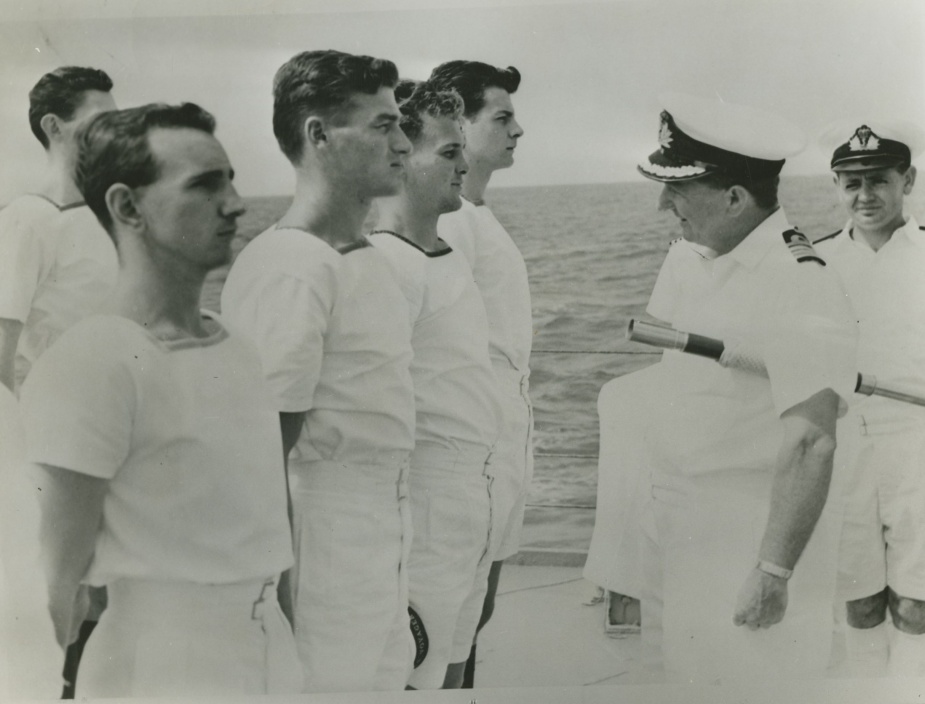
Voyager (II) emerged from dockyard hands on 23 January 1964, with a significant percentage of her crew new to the ship, and took passage to Sydney, where she arrived on 25 January, in preparation for workup prior to a South East Asian deployment. To the end of January, Voyager (II) had steamed a total of 218,300.4 miles since commissioning.
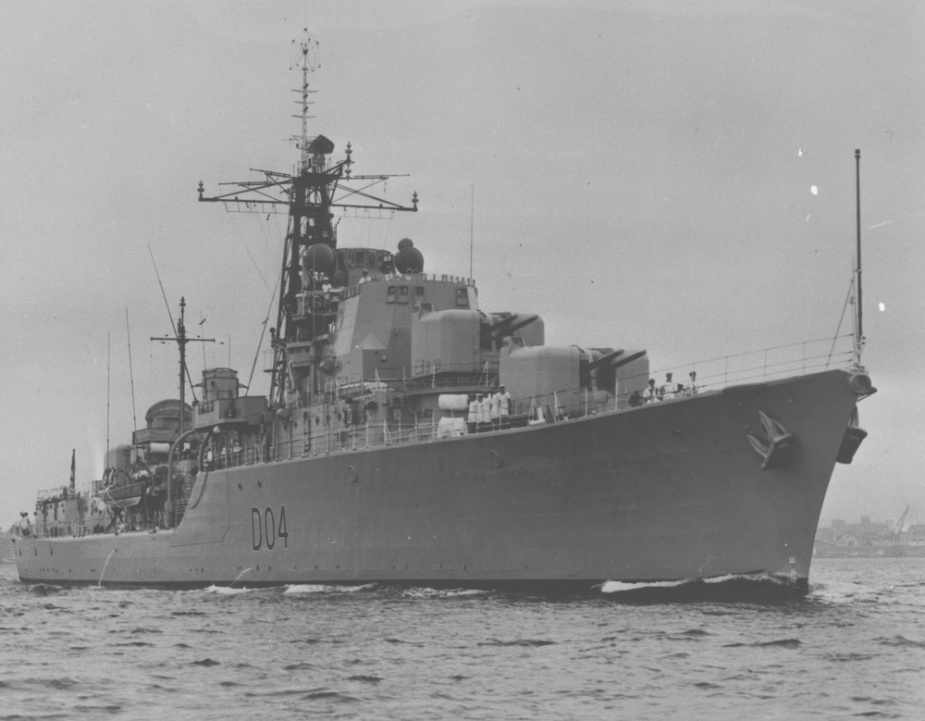
On 6 February Voyager (II) embarked ammunition in Sydney Harbour, before sailing for the Jervis Bay Exercise Areas. Voyager (II) and Melbourne (II) anchored in Jervis Bay at midday, Sunday 9 February, allowing the sportsmen in their ship's companies to enjoy the facilities provided by HMAS Creswell .
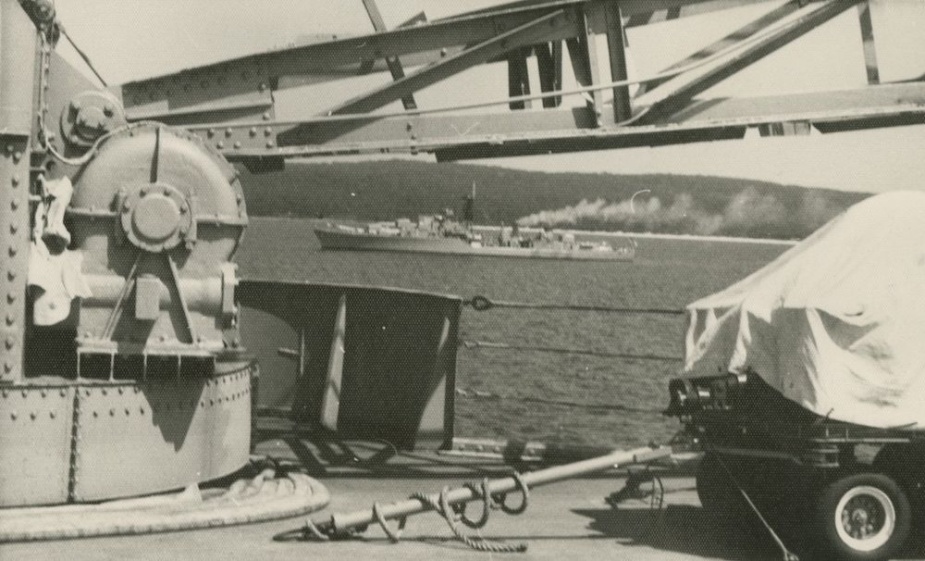
Both ships sailed from Jervis Bay early on Monday 10 February, with the day being spent in the local exercise areas conducting a series of trials and exercises. For Voyager (II), these included a shore bombardment exercise (08:30-10:30), and an anti-submarine exercise with the submarine, HMS Tabard (13:00-18:00). Following this latter exercise, Voyager (II) closed Melbourne (II) for the first time that day, for transfer of mail by heaving line. This was followed by radio sea trials between the two ships.
On the night of Monday 10 February 1964, HMAS Melbourne (II) was engaged in night flying exercises off the New South Wales coast. Voyager (II)’s role was that of plane guard, involving the rescue, if necessary, of aircrew personnel from the sea. Since both ships had just completed refits, this was the first time they had been involved in close quarters maneuvering for almost six months. Both the carrier and destroyer were ‘darkened’ with only navigational/operational lighting in use.
At approximately 20:56, some twenty miles south east of Jervis Bay, the two ships were in collision. Melbourne (II) struck Voyager (II) at the aft end of her bridge, heeling her over to an angle of about 50 degrees. A flash appeared to come from Voyager (II)’s ‘A’ Boiler, and she emitted high pressure steam and black smoke. Debris, including the revolution table from Voyager (II)’s bridge, and a pair of binoculars, was thrown onto Melbourne (II)’s flight deck.
The impact pushed Voyager (II) bodily through the water for a few seconds, and then she broke in two. Her forward section passed down Melbourne (II)’s port side, and the stern section down the starboard side. The forward section sank soon afterwards and the after section about three hours later. The disaster resulted in the loss of 82 lives (14 officers, including the Commanding Officer, 67 sailors and one civilian dockyard employee). There were 232 survivors. Melbourne (II) was damaged but sustained no casualties.
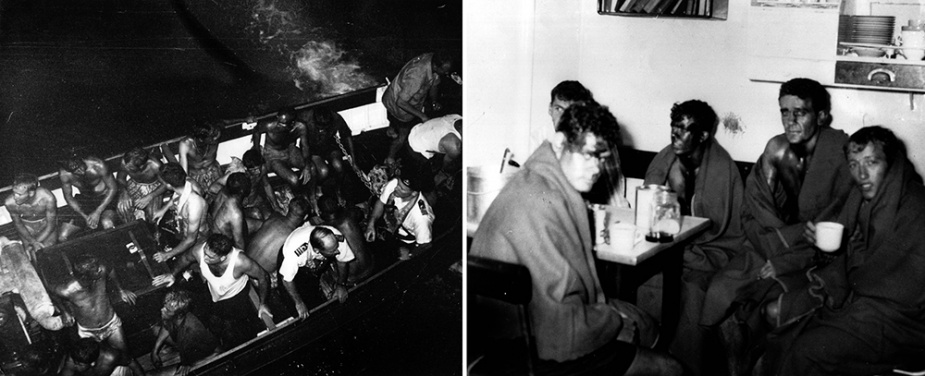
The wreck of HMAS Voyager (II) lies some 600 fathoms deep, twenty nautical miles off Cape Perpendicular on a bearing of 120 degrees.
On 21 February 1964 memorial services were held throughout Australia, enabling thousands of people to pay their respects to those of Voyager (II)’s ship’s company who had lost their lives. A moving and impressive inter-denominational service was conducted in HMAS Nirimba . Tributes to the missing sailors were paid by Captain McMurray, Father Lyons and Chaplain Batt; and prayers were said for the deceased and bereaved. The service concluded after two minutes’ silence with the playing of the ‘Last Post’, and the reading of the Naval Prayer and the Lord’s Prayer.
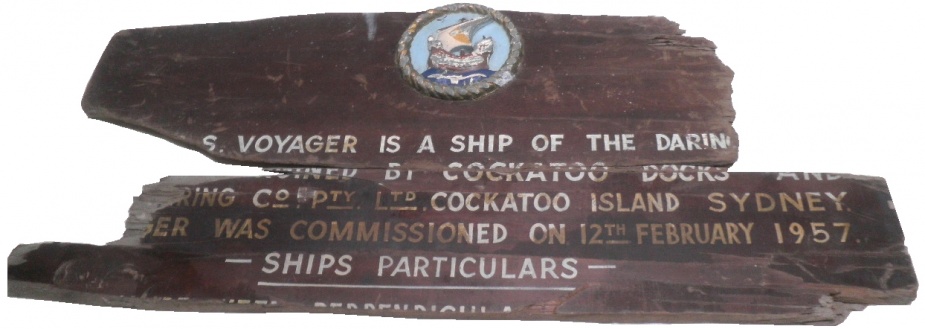
The following item is taken from the front page of the (Royal Australian) Navy News of Friday 19 March 1965, under the headline “Queen Honours Voyager Men”.
George Cross Medal...(Late) Chief Petty Officer Rogers helped many men to escape from the Voyager (II)’s rapidly sinking forward section. In the darkness and confusion following the collision, he organised the evacuation of the cafeteria where there were between 50-60 men. He stayed behind to look after those who could not escape, and led them in prayer and a hymn. He upheld the highest tradition of service at sea, and his rating as Chief Petty Officer (Coxswain). Chief Petty Officer Rogers was awarded the Distinguished Service Medal for service with the Royal Navy in 1944. He transferred to the RAN in 1950. Electrical Mechanic (Electronics) First Class William Joseph Condon, Albert Medal for Gallantry in saving life at sea. In recognition and his outstanding gallantry and devotion to duty in saving life at sea when HMAS Voyager was sunk after collision, in remaining at his post to the end in the sinking ship, holding the emergency lantern to show others the path to the escape scuttle and losing his life thereby. Midshipman Kerry Francis Marien, Albert Medal for gallantry in saving life at sea. In recognition of his gallantry in attempting to save life at sea when HMAS Voyager was sunk after collision. In leaving the safety of a life raft to attempt a rescue, he thereby lost his life. Petty Officer Douglas Moore, George Medal. In recognition of his brave and distinguished conduct when HMAS Voyager was sunk after collision, in assisting the survivors to evacuate the sinking ship, and in rescuing an unconscious man in the water, and for leadership and devotion to duty in organising the boarding of life-rafts and taking charge of life-rafts containing survivors in great adversity. (Petty Officer) Moore was awarded the British Empire Medal for his part in a hazardous diving operation undertaken by the Navy for the Snowy Mountains Authority at Lake Eucumbene in 1961). Leading Seaman Raymond Ernest Rich, British Empire Medal. In recognition of his brave and distinguished conduct when HMAS Voyager was sunk after collision, in assisting with the maintenance of moral of survivors in the ship and the orderly evacuation of the sinking ship, in rescuing a man who was drowning, for leadership and devotion to duty in organising the boarding of life rafts containing the survivors, and maintaining the morale of survivors in great adversity. Petty Officer Geoffrey Percival Worth, British Empire Medal. In recognition of his brave and distinguished conduct when HMAS Voyager was sunk after collision, in assisting survivors to evacuate the sinking ship, in leaving the safety of the life raft to rescue a drowning man, and for leadership and devotion to duty in organising the boarding of life-rafts and taking charge of life rafts containing survivors and in maintaining the moral of survivors in great adversity. Leading Electrical Mechanic Brian Victor Longbotham, British Empire Medal. In recognition of his brave conduct when HMAS Voyager was sunk after collision, in remaining in the water by the sinking ship, assisting survivors and organising them into a party, and for personal courage in leaving the safety of a lifeboat to rescue a drowning man. Leading Sick Berth Attendant John Rennie Wilson, British Empire Medal. In recognition of his brave and distinguished conduct when HMAS Voyager was sunk after collision, in that although in great pain from his injuries, he refused an injection of morphia and insisted on helping other injured men, thereby upholding the highest traditions of the nursing profession. Able Seaman Eric Noel Robson, British Empire Medal. In recognition of his brave conduct when HMAS Voyager was sunk after collision, in showing others the escape route in the sinking ship and assisting them towards the escape hatch before escaping himself. Petty Officer Engineering Mechanic Edgar James McDermott, Queen’s Commendation. For brave conduct and devotion to duty when HMAS Voyager was sunk after collision, in remaining at his post in B boiler room in near darkness, assessing the damage, closing down the hatches and air locks, shutting down high pressure boilers at considerable risk to his personal safety, in order to ensure that the boiler did not explode, which would have caused disaster to those on the after section. Engineering Mechanic Hugh Francis Gilvarry, Queen’s Commendation. In recognition of his brave conduct and devotion to duty when HMAS Voyager sank after collision, in remaining at his post as diesel fuel pump watchkeeper alone in the after engine room in order to ensure the continued operation of the diesel generator, which was the only remaining source of power, until ordered to abandon ship. Electrical Artificer Second Class Anthony Page, Queen’s Commendation. In recognition of his brave conduct and devotion to duty when HMAS Voyager was sunk after collision, in entering B engine room to start the diesel generator so that power was restored to the after section of the ship, without which the other measures being taken to preserve the ship and safety of the crew would have been very difficult.
For further reading please see the biographies of Chief Petty Officer Jonathan Rogers and Midshipman Kerry Francis Marien .
The list of casualties
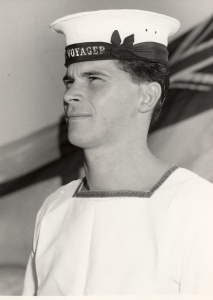
The following is the official list of the bodies of those recovered and those missing:
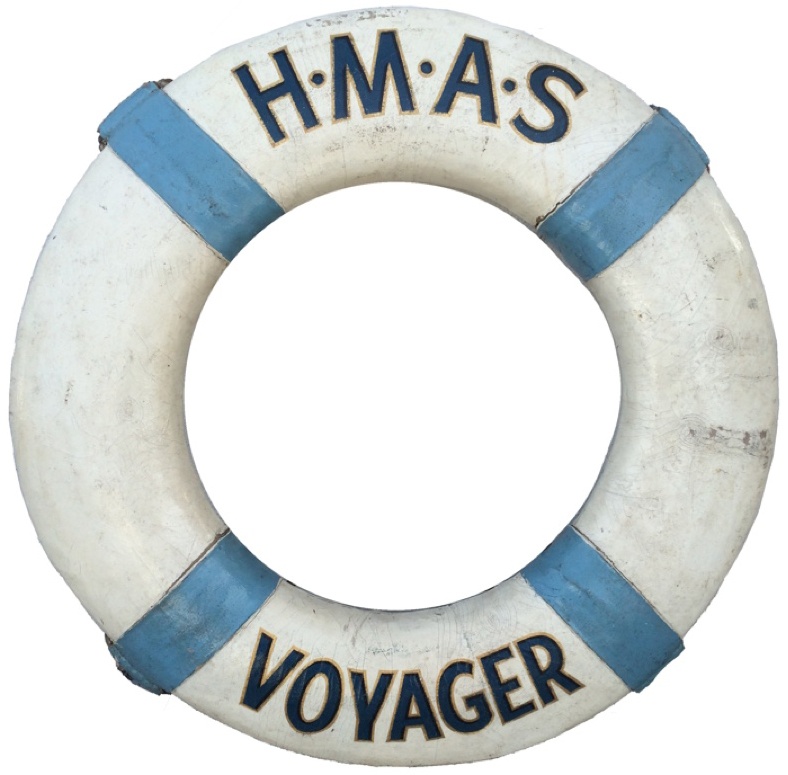
Commanding Officers of HMAS Voyager (II)
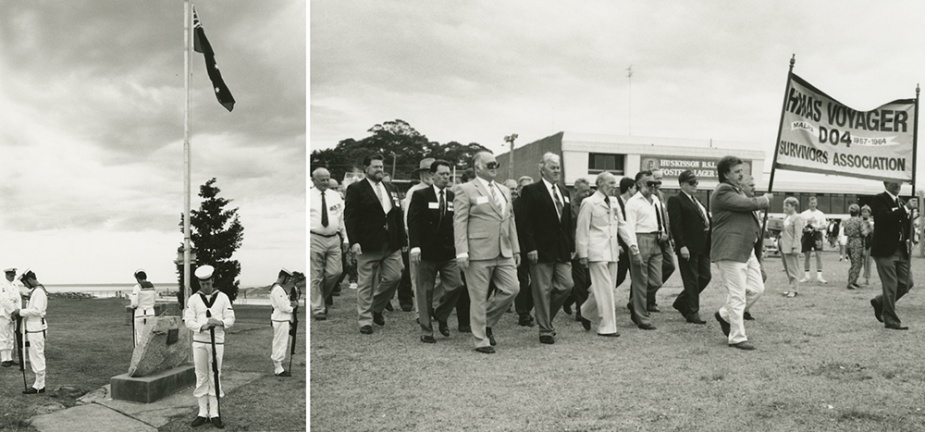
The New South Wales town of Huskisson on the shores of Jervis Bay has an HMAS Voyager (II) memorial park, details of which can be found at monumentaustralia.org.au .
There is also a memorial at Voyager Park, bordered by Sirius Road and Orlando Crescent in the Sydney suburb of East Hills. To the north of Sirius Road lies Voyager Point which runs alongside the Georges River.
HMAS Cerberus has an HMAS Voyager (II) memorial, featuring a bronze statue of a sailor on a stone cairn.
The Devonport (Tasmania) Maritime Museum, formerly the Harbour Master's residence and pilot station, also features a memorial commemorating HMAS Voyager (II). It reads:
The naval destroyer HMAS Voyager (II) was lost on the night of 10 February 1964 in a collision with the aircraft carrier HMAS Melbourne (II). Nine Tasmanians were serving on the Voyager (II), four of whom were among the eighty-two men who died that night: AB Neil Benjamin Brown Ordinary SMN John David Clayton Ordinary SMN Graham Dennis Fitzallen Leonard Charles Lehman (cook)
Lieutenant HD Cook and Voyager (II) Memorial Fund
The 7 August 1964 edition of Navy News carried the following article:
The Airdmillan State School Parents and Citizens’ Association has established a fund to be known as the HD Cook and Voyager (II) Memorial Fund. Some months ago a suggestion was made that a fund be established to perpetuate the memory of the late Lieut Harry Cook, a past pupil of the school, who lost his life in the Voyager (II) disaster. Harry was the eldest son of Mr and Mrs Ron Cook, residents of Airdmillan for many years. At the July meeting of the Association it was decided to sponsor an annual award in the juvenile section of the North Queensland Eisteddfod to be known as the ‘Lieut HD Cook and Voyager (II) Memorial Award’...The Association also decided to place framed photos of Lieut Cook and of Voyager (II) in the classroom of the Airdmillan State School.
Ship’s Bell
The Perth Sub-Section of the Naval Association of Australia recently presented a ship’s bell to HMAS Leeuwin (I) as a memorial to the four junior recruits who lost their lives in HMAS Voyager (II) on February 10 last year. The four were EM JH Curgenvan, EM NG Diepenbroek, Ord SMN KL Muller, and Ord RO JB Trautman.

HMAS Voyager (II) Trophy
Lost with HMAS Voyager (II) was the Otranto Shield for Torpedo, the tactical anti-submarine warfare trophy that she had won in 1963. On 10 February 1984 the RAN instituted the HMAS Voyager (II) Trophy for anti-submarine warfare proficiency, to be awarded annually to the “...escort which in the opinion of the Fleet Commander has achieved the best and most consistent anti-submarine sensor and weapon performance during the year.”
The inaugural winner was the guided missile frigate HMAS Canberra (II) for the year ended 1983. The most prolific winners have been HMAS Darwin with five awards, and HMAS Perth (II) with four.
HMAS Voyager (II) Battle Honour Board
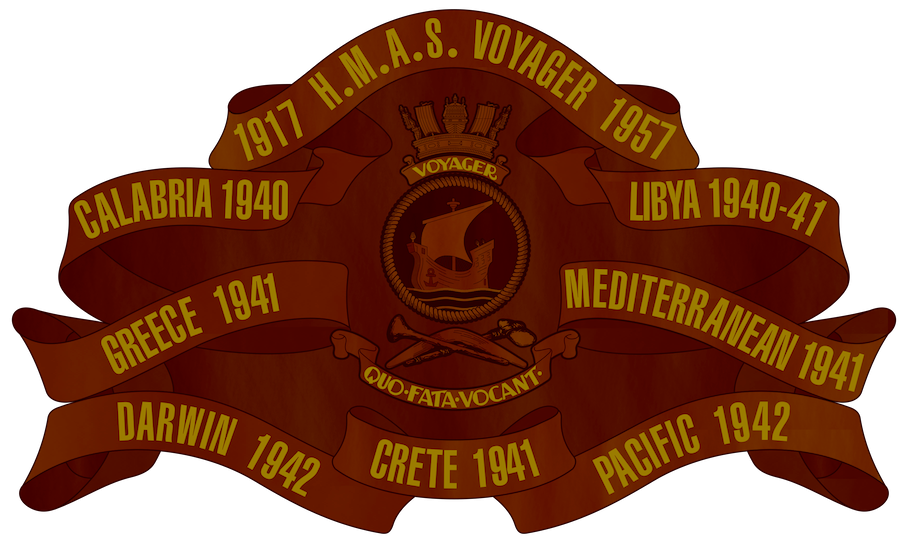
Official Reports
Official printed papers, periodicals.
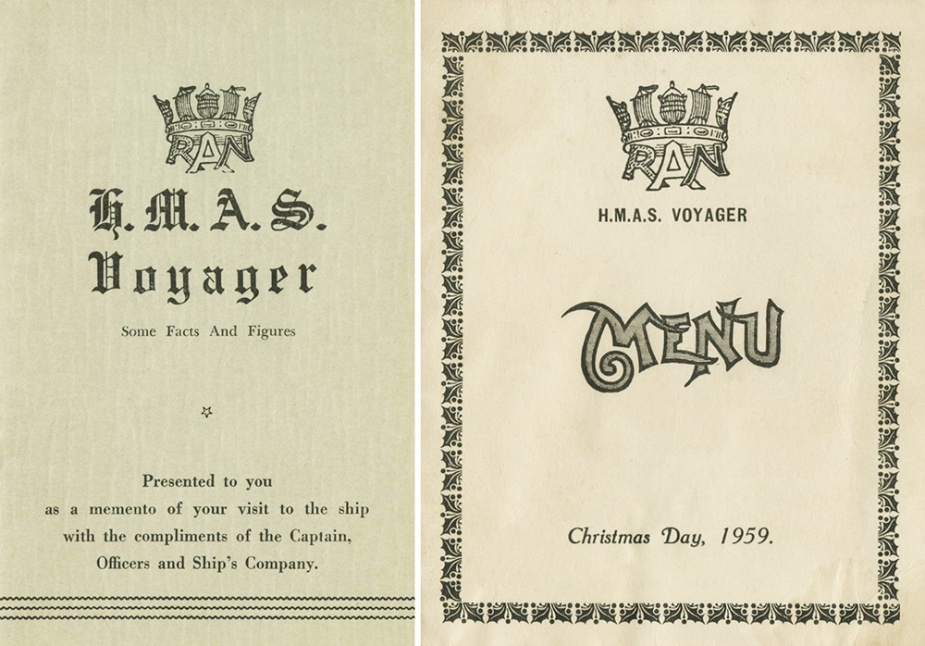
Related Content
- Chaplain Cyril David Alcorn MBE

To fight and win at sea.
Utility Links
- Accessibility
- Privacy Policy
Footer Info

- Skip to primary navigation
- Skip to main content
- Skip to primary sidebar
Naval Historical Society of Australia
Preserving Australia's Naval History
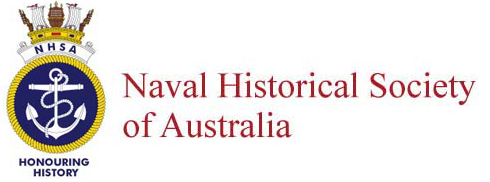
The Melbourne/Voyager Collision – Untold Story
Stephen, Kerry · Jun 21, 2009 · Print This Page
On 10th February 1964 the Search and Rescue (SAR) crews arrived at the Marine Section at the usual time, 0750, to have their coffee and prepare for another day’s work. Twenty four hours later two of those crews had saved the lives of seventy men from HMAS Voyager . Their experiences that night have never been publicly documented. This is the story of Air Nymph , one of the boats involved in the rescue operations that fateful night.
The Marine Section, HMAS Creswell was a rather unique organisation, because although it was located in, and administered by, Creswell , it was under the operational control of the Naval Air Station HMAS Albatross . As such, it worked the same hours as Albatross . When flying operations were being carried out in the Jervis Bay area by Albatross or HMAS Melbourne , it remained operationally ready until Albatross reported that fixed wing air operations had ceased for the day. Only then would the duty SAR crew stand down until the following day. This meant that, during squadron workup periods prior to embarkation in Melbourne , or during major naval exercises, the duty crew were often on duty in the Marine Section from 0600. until approximately midnight.
A ‘hot line’, which was directly connected to the Air Traffic Control tower (ATC) in Albatross , was located in the Marine Section Officers’ office. This ‘hot line’ was tested at 0900 every morning between the two stations to ensure that instant communications were available between the ATC and the Marine Section. Alongside the ‘hot line’ was an Emergency button. When pushed it activated an Air Raid siren which sounded throughout the whole of Creswell to recall off duty SAR crew members and also warn Creswell staff of an emergency taking place. It was an operational requirement that the duty SAR crew left within 10 minutes of any emergency being sounded.
Although the Marine Section operated four SARs, the complement allowed for three crews to man the boats as one SAR was usually undergoing refit in Garden Island Dockyard. Three of the vessels, Air Nymph , Air Faith and Air Chief were all wooden hulled American built ex-World War II air sea rescue craft. The fourth, Air Sprite , was built to the same design, in the 1950s, by Halvorsen’s Shipyard. They were powered by two Hall Scott Defender 630 HP V12 engines, with two fuel tanks holding 1200 gallons of super petrol, and during World War II operated at 33.5 knots. However, because of their high fuel consumption they were governed down to a maximum speed of 28 knots. A searchlight was fitted outboard each side of the bridge for communications or search purposes. Although only two officers were borne in the Marine Section complement, Sub Lieutenant Tony Vodic and myself, each crew consisted of an officer (Lieutenant/Sub Lieutenant) in command, a seaman Petty Officer, a radio operator, a Leading Seaman (LS)/Able Seaman (AB) electrical sailor, three AB Seamen branch, an LME (leading mechanical engineer),and two MEs (MTPs),
On 10th February 1964 only two SARs were based in Creswell, Air Sprite and Air Nymph . Both Air Chief and Air Faith were undergoing maintenance or refit in Garden Island Dockyard. The two boats were taken out for their usual morning run in Jervis Bay to ensure that they were fully operational. It was likely to be a busy day; Melbourne was carrying out flying operations with Voyager , the consort and rescue destroyer. Three minesweepers (MCMVs) were also due in Jervis Bay to carry out mine countermeasure (MCM) exercises.
The two SARs returned to the Marine Section wharf where they were refueled, and the crews then carried on with their normal ship husbandry and maintenance routines. At 1600 the standby crews departed at the end of the day’s work, leaving the duty crew led by Petty Officer Ron Budd in the Marine Section. Air Nymph was the duty boat and I was the Duty Officer for that night. The routine was as normal, the duty crew having dinner in the Marine Section galley while they waited for the cessation of flying operations.
It was anticipated it would be a quiet night so everyone relaxed in the mess facilities. About 2000 that evening noise was heard in the vicinity of the Creswell swimming pool on the waterfront. Several of the duty crew went out to the Marine Section wharf to see what was going on. It turned out to be an initiation ceremony for new entry Cadet Midshipmen so they returned to the mess, advising me accordingly.
The ‘hot line’
But it was not to be a quiet night! At 2057 the ‘hot line’ suddenly rang. I immediately answered the phone to hear the Albatross duty ATC officer say ‘ Melbourne and Voyager have collided in a position 20 miles from Point Perpendicular, on a bearing of 120 degrees, scramble the SARs’. I instantly hit the Emergency button, sounding the siren, and rushed downstairs to the crew mess where I told the duty crew that Melbourne and Voyager had collided and to prepare the duty boat, Air Nymph , to get underway immediately. The crew quickly responded, boarded the boat, started the engines and made preparations to sail. Fortunately, a Surgeon Lieutenant was in the vicinity of the Marine Section at that time, so I requested he board Air Nymph to provide medical assistance if required.
- Research – We can help!
- Naval Heritage Sites
- Garden Island Dockyard Heritage Tour
- Members Area
Voyager memorial: disaster survivors remember the sinking 50 years on
Topic: Maritime Accidents and Incidents
HMAS Melbourne after crashing with HMAS Voyager in 1964. ( ADF )
Memorial services marking the 50th anniversary of Australia's worst peacetime maritime disaster are today taking place at Jervis Bay on the NSW south coast.
Eighty-two men on board HMAS Voyager were killed after it collided with aircraft carrier HMAS Melbourne during a training exercise on February 10, 1964.
The Voyager was cut in half, but 232 people survived.
Many of the survivors will join with families of the victims and dignitaries for several commemorations, starting at 8:30am today with a memorial church service at HMAS Creswell's chapel.
One of the main events on Monday will be a memorial service at the wreck site of HMAS Voyager, about 20 nautical miles off Cape Perpendicular.
There will also be a sunset ceremony with an 82-bell toll to honour each life lost.
The HMAS Melbourne at sea off NSW following a collision with the destroyer HMAS Voyager on the night of Feb. 10, 1964. ( Courtesy of the Australian War Memorial )
The tragedy has had ramifications for years, with many sailors experiencing post traumatic stress disorder (PTSD).
There was no counselling, just a week's survivor's leave.
The subsequent cover-up by the Government and the Navy led to an unprecedented two royal commissions in pursuit of the truth.
Both inquiries were critical of the Voyager's captain and the second inquiry examined new evidence about his drinking and health.
Captain Duncan Stevens was eventually deemed unfit to command due to medical reasons.
But some survivors do not want to take part in the commemoration ceremonies.
"A lot of them, I think, have just found if they don't acknowledge it and shut it up, bottle it up, it never happened," survivor 'Bluey' Ducker said.
"They don't want to remember, don't want to even associate with their old shipmates."
Re-fitted ships 'not up to speed'
The former Chief of the Defence Force, Admiral Chris Barrie, has reflected on his own experience of the Voyager disaster 50 years ago.
We're never really going to know what happened on the night of the collision.
Admiral Barrie was a young cadet at Jervis Bay when the HMAS Voyager collided with the aircraft carrier HMAS Melbourne.
He lamented the loss of life and the lack of information about what really happened.
"We're never really going to know what happened on the night of the collision, except when I look at the paperwork what I see is two ships in post refit trials," he said.
"Neither had been at sea for very long, and having been through post refit trials myself I know that the ships weren't up to speed in operational capacity."
Donate Today
Report of Royal Commissioner on loss of H.M.A.S. "Voyager" : Melbourne, 13th August,1964 / Sir John Spicer (Commissioner).
Shelf items, share this page.
- Share on Facebook
- Share on Twitter
- Share using email
Related information
- Voyager (Destroyer : 1952-1964)
- Melbourne (Aircraft carrier)
- Navies - Australia.
- Collisions at sea.

IMAGES
COMMENTS
The Melbourne-Voyager collision, also known as the Melbourne-Voyager incident or simply the Voyager incident, was a collision between two warships of the Royal Australian Navy (RAN); the aircraft carrier HMAS Melbourne and the destroyer HMAS Voyager.. On the evening of 10 February 1964, the two ships were performing manoeuvres off Jervis Bay. Melbourne 's aircraft were performing flying ...
The Melbourne-Voyager collision is one of the RAN's most devastating disasters. For so many men to be killed in a training exercise severely damaged the RAN's standing with the Australian Government and public. It also highlighted numerous weaknesses and OOW standards, Command Team training and operational procedures were improved as a ...
On the night of 10 February 1964, 20 nautical miles south-east of Jervis Bay, the Royal Australian Navy's aircraft carrier HMAS Melbourne collided with the destroyer HMAS Voyager. The smaller ship was cut in two with the forward section sinking in the 10 minutes following the 8.56pm collision. The after section sank by midnight.
A veteran from the HMAS Melbourne and HMAS Voyager collision on February 10, 1964 that killed 82 people believes changes to floodlighting on the aircraft carrier caused Australia's worst peacetime ...
But by the time they realised Voyager was still turning to port - and therefore would pass in front of Melbourne - it was too late to avoid a collision. Wristwatch worn by Mike Hallen on the night of the collision between HMAS Voyager and HMAS Melbourne. National Maritime Collection, 00016919, gift from M W J Hallen
On the evening of February 10 1964, Australia's worst peacetime naval disaster occurred, when the aircraft carrier HMAS Melbourne collided with the destroyer HMAS Voyager. The disaster, which ...
Their first sight was the massive hole ripped in Melbourne's bow, the half of Voyager still floating but sinking fast and life rafts full with shocked, injured, and deceased sailors.. This was the assault on the senses that 24-year-old Lieutenant Kerry Stephens faced when his command HMAS Air Nymph, a SAR vessel from HMAS Creswell arrived at the scene two hours after the collision.
The collision of HMAS Melbourne and HMAS Voyager is the Royal Australian Navy's worst peacetime disaster. We look back with this article from the archives. From the Archives, 1964: Hope Fades for ...
On the 10th of February 1964 a terrible naval accident took place in Australian waters that led to 82 deaths. Off the coast of the Royal Australian Navy base at Jervis Bay, the aircraft carrier, the HMAS Melbourne and the destroyer, the HMAS Voyager were conducting maneuvers when it soon became clear that the 2 ships were heading for collision.
On February 10, 1964, Mr Perrin became one of 232 sailors who survived the HMAS Voyager and HMAS Melbourne collision near Jervis Bay — one of the most traumatic maritime events in Australia's ...
At approximately 20:56, some twenty miles south east of Jervis Bay, the two ships were in collision. Melbourne (II) struck Voyager (II) at the aft end of her bridge, heeling her over to an angle of about 50 degrees. A flash appeared to come from Voyager (II)'s 'A' Boiler, and she emitted high pressure steam and black smoke.
HMAS Voyager was a Daring-class destroyer of the Royal Australian Navy (RAN), that was lost in a collision in 1964.. Constructed between 1949 and 1957, Voyager was the first ship of her class to enter Australian service, and the first all-welded ship to be built in Australia. During her career, Voyager was deployed to the Far East Strategic Reserve on six occasions, but never fired a shot in ...
551. 10 February 1964: On this day in 1964 the Melbourne Voyager collision occurred. 81 sailors and one civilian dockyard worker died. On this day in 2014, on the fiftieth anniversary of the disaster, Voyager survivors, and families and friends of those who died went to sea in HMAS Choules and scattered poppies where Voyager lies 20 nm from ...
The Melbourne-Voyager collision, also known as the Melbourne-Voyager incident or simply the Voyager incident, was a collision between two warships of the Royal Australian Navy (RAN); the aircraft carrier HMAS Melbourne and the destroyer HMAS Voyager. This article's lead section may be too long. (February 2021)
The Melbourne/Voyager Collision - Untold Story. On 10th February 1964 the Search and Rescue (SAR) crews arrived at the Marine Section at the usual time, 0750, to have their coffee and prepare for another day's work. Twenty four hours later two of those crews had saved the lives of seventy men from HMAS Voyager.
In the 1990s both Voyager and Melbourne men and their families pursued claims against the Government in court, with the last case being closed in 2009 - 45 years after the tragedy unfolded. Wristwatch worn by Mike Hallen on the night of HMAS VOYAGER and HMAS MELBOURNE collision. ANMM Collection Gift from M W J Hallen
Following the collision, the forward section of the Voyager broke off and sank within 10 minutes. The aft section initially remained afloat but, slowly, it began sinking into the sea, being ...
Professor Rob McLaughlin & his expert panel of Judge Sylvia Emmett, Professor Tom Frame, Lieutenant Commander Doug Moore, Commodore Brian Robertson & Vice Ad...
Survivors of the collision between HMAS ships Voyager and Melbourne have come together to remember the 50th anniversary of Australia's worst peacetime naval ...
The Melbourne-Evans collision was a collision between the light aircraft carrier HMAS Melbourne of the Royal Australian Navy (RAN) and the destroyer USS Frank E. Evans of the United States Navy (USN). On 3 June 1969, the two ships were participating in SEATO exercise Sea Spirit in the South China Sea.Around 3:00 am, when ordered to a new escort station, Evans sailed under Melbourne ' s bow ...
The HMAS Melbourne at sea off NSW following a collision with the destroyer HMAS Voyager on the night of Feb. 10, 1964. (Courtesy of the Australian War Memorial)The tragedy has had ramifications ...
On the night of 10 February 1964, during night flying operations, the RAN's flagship the aircraft carrier HMAS Melbourne (II) was in collision with the Darin...
Collection type: Library: Author: Australia. Royal Commission on Loss of H.M.A.S. Voyager.; Spicer, John Armstrong Sir, 1899-1978.; Call Number: F 359.00994 A938